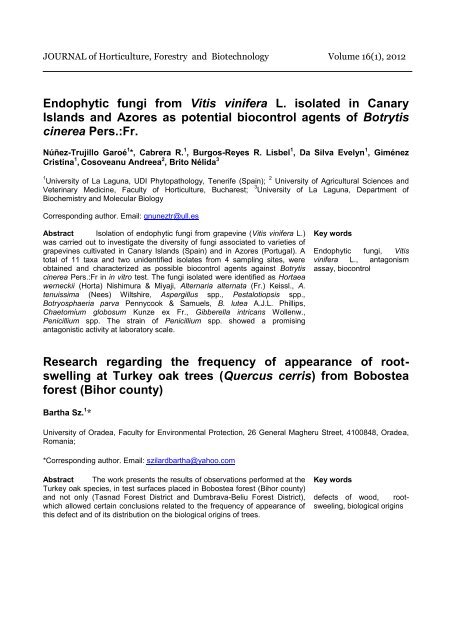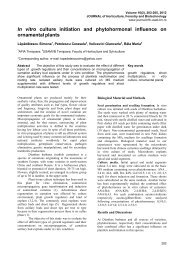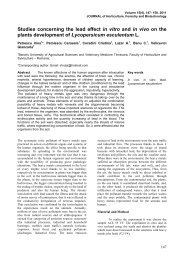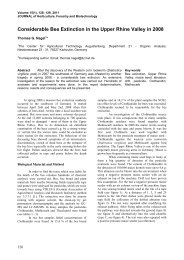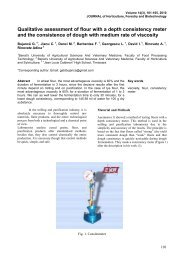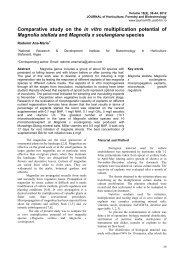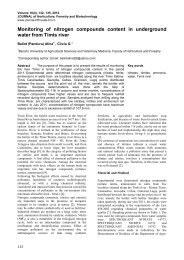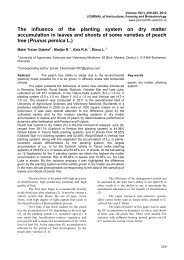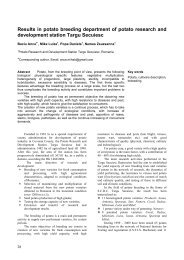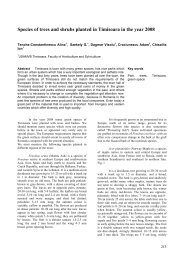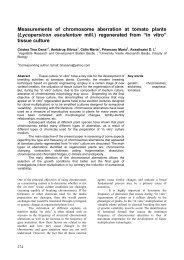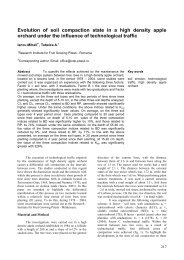Endophytic fungi from Vitis vinifera L. isolated in Canary Islands and ...
Endophytic fungi from Vitis vinifera L. isolated in Canary Islands and ...
Endophytic fungi from Vitis vinifera L. isolated in Canary Islands and ...
You also want an ePaper? Increase the reach of your titles
YUMPU automatically turns print PDFs into web optimized ePapers that Google loves.
JOURNAL of Horticulture, Forestry <strong>and</strong> Biotechnology Volume 16(1), 2012<strong>Endophytic</strong> <strong>fungi</strong> <strong>from</strong> <strong>Vitis</strong> <strong>v<strong>in</strong>ifera</strong> L. <strong>isolated</strong> <strong>in</strong> <strong>Canary</strong><strong>Isl<strong>and</strong>s</strong> <strong>and</strong> Azores as potential biocontrol agents of Botrytisc<strong>in</strong>erea Pers.:Fr.Núñez-Trujillo Garoé 1 *, Cabrera R. 1 , Burgos-Reyes R. Lisbel 1 , Da Silva Evelyn 1 , GiménezCrist<strong>in</strong>a 1 , Cosoveanu Andreea 2 , Brito Nélida 31 University of La Laguna, UDI Phytopathology, Tenerife (Spa<strong>in</strong>); 2 University of Agricultural Sciences <strong>and</strong>Veter<strong>in</strong>ary Medic<strong>in</strong>e, Faculty of Horticulture, Bucharest; 3 University of La Laguna, Department ofBiochemistry <strong>and</strong> Molecular BiologyCorrespond<strong>in</strong>g author. Email: gnuneztr@ull.esAbstract Isolation of endophytic <strong>fungi</strong> <strong>from</strong> grapev<strong>in</strong>e (<strong>Vitis</strong> <strong>v<strong>in</strong>ifera</strong> L.)was carried out to <strong>in</strong>vestigate the diversity of <strong>fungi</strong> associated to varieties ofgrapev<strong>in</strong>es cultivated <strong>in</strong> <strong>Canary</strong> <strong>Isl<strong>and</strong>s</strong> (Spa<strong>in</strong>) <strong>and</strong> <strong>in</strong> Azores (Portugal). Atotal of 11 taxa <strong>and</strong> two unidentified isolates <strong>from</strong> 4 sampl<strong>in</strong>g sites, wereobta<strong>in</strong>ed <strong>and</strong> characterized as possible biocontrol agents aga<strong>in</strong>st Botrytisc<strong>in</strong>erea Pers.:Fr <strong>in</strong> <strong>in</strong> vitro test. The <strong>fungi</strong> <strong>isolated</strong> were identified as Hortaeawerneckii (Horta) Nishimura & Miyaji, Alternaria alternata (Fr.) Keissl., A.tenuissima (Nees) Wiltshire, Aspergillus spp., Pestalotiopsis spp.,Botryosphaeria parva Pennycook & Samuels, B. lutea A.J.L. Phillips,Chaetomium globosum Kunze ex Fr., Gibberella <strong>in</strong>tricans Wollenw.,Penicillium spp. The stra<strong>in</strong> of Penicillium spp. showed a promis<strong>in</strong>gantagonistic activity at laboratory scale.Key words<strong>Endophytic</strong> <strong>fungi</strong>, <strong>Vitis</strong><strong>v<strong>in</strong>ifera</strong> L., antagonismassay, biocontrolResearch regard<strong>in</strong>g the frequency of appearance of rootswell<strong>in</strong>gat Turkey oak trees (Quercus cerris) <strong>from</strong> Bobosteaforest (Bihor county)Bartha Sz. 1 *University of Oradea, Faculty for Environmental Protection, 26 General Magheru Street, 4100848, Oradea,Romania;*Correspond<strong>in</strong>g author. Email: szilardbartha@yahoo.comAbstract The work presents the results of observations performed at theTurkey oak species, <strong>in</strong> test surfaces placed <strong>in</strong> Bobostea forest (Bihor county)<strong>and</strong> not only (Tasnad Forest District <strong>and</strong> Dumbrava-Beliu Forest District),which allowed certa<strong>in</strong> conclusions related to the frequency of appearance ofthis defect <strong>and</strong> of its distribution on the biological orig<strong>in</strong>s of trees.Key wordsdefects of wood, rootsweel<strong>in</strong>g,biological orig<strong>in</strong>s
Studies on Genetic Structure Variability at ‘Serata’, Lactucasativa L. VarietyAmbarus Silvica 1 *, Brezeanu P.M. 1 , Brezeanu Creola 11 Vegetable Research <strong>and</strong> Development Station Bacau*Correspond<strong>in</strong>g author. Email: silvia_ambarus@yahoo.comAbstract This paper presents a study on the variability of the ma<strong>in</strong> traits<strong>and</strong> significance of selection work at „SERATA‟ variety of Lactuca sativa L.created <strong>and</strong> patented at Vegetable Research <strong>and</strong> Development Station,Bacau. Ma<strong>in</strong>ta<strong>in</strong><strong>in</strong>g of quantitative <strong>and</strong> qualitative features of variety, annuallywith<strong>in</strong> their variability <strong>in</strong> purpose to ensure the identity, uniformity <strong>and</strong> stabilityis achieved by the conservative selection works. Our undertaken studiesshow that studied variability of different traits, is: low at shape‟s <strong>in</strong>dex, head‟sheight, medium at head diameter <strong>and</strong> head weight <strong>and</strong> high at weight of seed/ plant (g). Data presented <strong>in</strong> this study reveal that the variety of lettuce –„SERATA‟ is properly ma<strong>in</strong>ta<strong>in</strong>ed <strong>in</strong> conservative selection process, <strong>and</strong> thelimits of variability are normal.Key wordspopulation, gene, genotype,coefficient of variabilityL<strong>and</strong>scape policies – the <strong>in</strong>contestable elements of a territorydevelopmentFabian Claudia 1 *Faculty of Horticulture, USAMV, Bucharest, Romania - Department of L<strong>and</strong>scape, Biodiversity <strong>and</strong>Ornamental Horticulture*Correspond<strong>in</strong>g author. Email: klaudiafabian@gmail.comAbstract In recent decades l<strong>and</strong>scape began to <strong>in</strong>sert <strong>in</strong> the speech ofpolitical <strong>and</strong> <strong>and</strong> professionals factors as an important component of aterritory construction, such as a component of framework for quality lifeconstruction. The l<strong>and</strong>scape requires a harmonious <strong>and</strong> equilibratedconstruction between the two structures which def<strong>in</strong>e a territory:anthropogenic <strong>and</strong> natural environment. These arguments of l<strong>and</strong>scapediscourse f<strong>in</strong>d their support <strong>in</strong> l<strong>and</strong>scape policies as local regulationelements. Thus by adopt<strong>in</strong>g the European L<strong>and</strong>scape Convention thel<strong>and</strong>scape policies can be found at the leval of territory to prevent thedepreciation, the trivialization of the of European l<strong>and</strong>scape <strong>and</strong> even the lossof local identity.L<strong>and</strong>scape policies are aimed to strengthen the local image by susta<strong>in</strong><strong>in</strong>gtraditions <strong>and</strong> natural elements. The two models of l<strong>and</strong>scape policies shown<strong>in</strong> the article will expose two different approaches of the l<strong>and</strong>scape. In theFrench Regional Natural Park, the l<strong>and</strong>scape policies are used to expose thedynamic development of the territory, they represent one of the key po<strong>in</strong>ts ofthe territorial valorisation. In Romanian Natural Park, we f<strong>in</strong>d a l<strong>and</strong>scapeapproach directed to conservation <strong>and</strong> protection of natural <strong>and</strong> humanenvironment with<strong>in</strong> the protected area.Through these two models we will have a clear approach ofl<strong>and</strong>scape policies seen <strong>from</strong> two different angles: one refers to theprogressive elements that stimulates a territory, <strong>and</strong> the other at theRomanian case, where <strong>in</strong> the absence of a l<strong>and</strong>scape legislation thel<strong>and</strong>scape is seen as a conservative component.Key wordsl<strong>and</strong>scape policies, NaturalPark, Regional NaturalPark, l<strong>and</strong>scape protection
Gared variety - result of potato breed<strong>in</strong>g research at Station forResearch <strong>and</strong> Development of Potato Targu SecuiescBaciu Anca 1 *, Motica R. 1 , Mike Luiza 11 Potato Research <strong>and</strong> Development Station Targu Secuiesc*Correspond<strong>in</strong>g author. Email: anca.mihab@gmail.comAbstract Potato, <strong>from</strong> the breed<strong>in</strong>g po<strong>in</strong>t of view, presents the follow<strong>in</strong>gbiological physiological specific features: vegetative multiplication,heterogeneity of progenitors‟, large plasticity, sterility, <strong>in</strong>compatible tohybridization, excessive sensibility to diseases. The first three specificfeatures advantage the breed<strong>in</strong>g process on a large scale, but the last twothus complicates the breed<strong>in</strong>g activity <strong>and</strong> constitutes important problems tosuccess.The breed<strong>in</strong>g of potato has as permanent objective the obta<strong>in</strong><strong>in</strong>g newvarieties with high yield capacity, with high resistance to diseases <strong>and</strong> pest,with high quality, which have to give the satisfaction to consumers.The creation of new potato varieties is a cont<strong>in</strong>ue process, which has to take<strong>in</strong>to account the change of ecological conditions, with <strong>in</strong>crease ofaggressively <strong>and</strong> pathogenity of diseases <strong>and</strong> pest, apparition of rases,stems, brotypes, pathotipes, as well as the cont<strong>in</strong>ue <strong>in</strong>creas<strong>in</strong>g of consumersdem<strong>and</strong>s.Key wordspotato, variety, breed<strong>in</strong>g,specific technologyResults concern<strong>in</strong>g the behaviour of certa<strong>in</strong> potato varieties(Solanum tuberosum L.) suitable for <strong>in</strong>dustrial process<strong>in</strong>gunder various ecological conditionsBaciu Anca 1 *, Motica R. 1 , Mike Luiza 1 , Cioloca Mihaela 21 Potato Research <strong>and</strong> Development Station – Târgu Secuiesc, Romania; 2 National Instituteof Research <strong>and</strong> Development for Potato <strong>and</strong> Sugar Beet Brasov*Correspond<strong>in</strong>g author. Email: anca.mihab@gmail.comAbstract The issue of discover<strong>in</strong>g new raw materials for the food <strong>in</strong>dustryis be<strong>in</strong>g considered a major concern <strong>in</strong> the whole world. This concern is theresult of both the need for diversification <strong>and</strong> improvement of the range offoods offered to the consumers <strong>and</strong> the dem<strong>and</strong> to provide with food aconstantly grow<strong>in</strong>g population.The world we live <strong>in</strong> is progress<strong>in</strong>g at an astonish<strong>in</strong>g pace, time be<strong>in</strong>g one ofour most important resources. As a result, consumer society is orientedtowards a food market based on the superior valorification of the vegetalproduction, which can assure a high nutritional potential.Dur<strong>in</strong>g the last decades attempts have been made throughout the world todiversity <strong>and</strong> <strong>in</strong>tensify the ma<strong>in</strong> crop cultures, among them the potato culture,which serves as a raw material <strong>in</strong> <strong>in</strong>dustry for: starch, glucose, dextr<strong>in</strong>,isoglucose etc.The aim of the experiment was to check the production potential ofstarch at varieties <strong>in</strong>tended for <strong>in</strong>dustrialization <strong>and</strong> to choose the mostappropiate varieties to be processed <strong>in</strong>to starch <strong>and</strong> which can be cultivated<strong>in</strong> areas favourable for potato culture.Key wordspotato, variety, productivity,starch content
L<strong>and</strong>scape plann<strong>in</strong>g proposal for the roundabout Card<strong>in</strong>alPo<strong>in</strong>ts with ornamental plants suitable for trafficBăla Maria 1 , Toţa Crist<strong>in</strong>a Elena, 1 Berar C. 1 , Silivăşan M. 1 , Florişteanu Alex<strong>and</strong>ra 11 Banat‟s Univesity of Agricultural Sciences <strong>and</strong> Veter<strong>in</strong>ary Medic<strong>in</strong>e, Timisoara, Faculty of Horticulture <strong>and</strong>ForestryCorrespond<strong>in</strong>g address. Email: mariabalamonicabala@yahoo.comAbstract To achieve development proposal has been considered thefunctionality of space <strong>and</strong> its aesthetics. First it wants to be a transit functionspace, which acts roundabout: high traffic area, spots of color to thevegetation, which creates a nice image for people mov<strong>in</strong>g permanently.In ornamental floriculture design<strong>in</strong>g a project must take <strong>in</strong>to accountcerta<strong>in</strong> basic pr<strong>in</strong>ciples: pr<strong>in</strong>ciples of functional, aesthetic, environmental,technical <strong>and</strong> cultural-historical. Systematization of each green space mustmeet functional goals of the program <strong>and</strong> ensure compliance with theorganization functions by rational arrangement of components <strong>and</strong> layoutlogic choice endowments.Key wordsl<strong>and</strong>scape plann<strong>in</strong>g, plant,aesthetics, trafficResearch on the behavior of some Rose cultivars belong<strong>in</strong>g toThea hybrida <strong>and</strong> Polyantha group, regard<strong>in</strong>g the propagationthrough cutt<strong>in</strong>gs on different soil substratum at the DidacticBase of the Discipl<strong>in</strong>e of FloricultureBăla Maria 1 , Toţa Crist<strong>in</strong>a Elena, 1 Berar C. 1 , Silivăşan M. 11 Banat‟s Univesity of Agricultural Sciences <strong>and</strong> Veter<strong>in</strong>ary Medic<strong>in</strong>e, Timisoara, Faculty of Horticulture <strong>and</strong>ForestryCorrespond<strong>in</strong>g address. Email: mariabalamonicabala@yahoo.comAbstract The uncontestalbe beauty of plants, but mostly offlowers, go often <strong>in</strong> a tight brace with their perfume, which is varied <strong>in</strong>composition <strong>and</strong> <strong>in</strong>tensity. This has went to the diverse use of species <strong>and</strong>cultivars <strong>and</strong> has taken to the apparition of a great <strong>in</strong>dustry of produc<strong>in</strong>g theseedl<strong>in</strong>g material, to which the cultivation of Roses has always meant animportant <strong>in</strong>come source of those who are busy with it‟s cultivation.In the present paper we have followed the root<strong>in</strong>g procentage of theRose cutt<strong>in</strong>gs that were provided by the n<strong>in</strong>e cultivars taken <strong>in</strong>to research, ondifferent root<strong>in</strong>g substratum: Casanova cv., Chrysler Imperial cv., Dame deCoeur cv., Gaumo cv., Kimono cv., Kronenburg cv., Mr. L<strong>in</strong>coln cv., Sterl<strong>in</strong>gcv., Sultane cv. The treatment of the results was done by us<strong>in</strong>g the currentstatistic methods, show<strong>in</strong>g the root<strong>in</strong>g capacity of the biological matherialused <strong>in</strong> the experiments.Key wordscultivars, Roses, cutt<strong>in</strong>gs,substratum, root<strong>in</strong>g
Effects of appl<strong>in</strong>g EU legislation on cultivation of transgenicherbicide-resistant soybean <strong>in</strong> RomaniaBalaj I. 1* , Nedelea G. 1 , Badea Elena Marcela 21 Banat‟s University of Agricultural Sciences <strong>and</strong> Veter<strong>in</strong>ary Medic<strong>in</strong>e Timisoara, Faculty of Horticulture <strong>and</strong>Forestry; 2 Institute of Biochemistry, Romanian Academy, 296, Splaiul Independenţei, 6 th district Bucharest,Romania*Correspond<strong>in</strong>g author. e-mail: claudia_balaj@yahoo.comAbstract Romania is one of the few European countries with favorableconditions for soybean production. Herbicide tolerant soybeans (RoundupReady, RR) were grown commercially beg<strong>in</strong>n<strong>in</strong>g with 1999 <strong>and</strong> accounted for68% of all soybeans planted <strong>in</strong> 2006. This technology has provided farmerswith productivity improvements through a comb<strong>in</strong>ation of yield improvements<strong>and</strong> cost reductions. On January 1, 2007, when jo<strong>in</strong><strong>in</strong>g the European Union,Romania had, <strong>in</strong> accordance with obligations under the Treaty of Accession,to stop GM soy cultivation, although grow<strong>in</strong>g this crop generated substantiallyhigher net farm <strong>in</strong>come ga<strong>in</strong>s per hectare than <strong>in</strong> any of the other countryus<strong>in</strong>g this technology. Follow<strong>in</strong>g the implementation of EU law, Romaniabecame the only country that prohibited the use of transgenic plants, plantsthat brought substantial profits not only to farmers. In only two years, the areaplanted to soybeans has shrunk with 70%, while Romania became a netimporter of vegetable prote<strong>in</strong>, just like the European Union itself. In 2008, EU-27 produced only 0.65 million tones of soybean. The EU annually imports15.4 millions of soybean <strong>and</strong> 24-25 millions of soybean meal. Therefore, thisGMO is not cultivated, but is imported <strong>in</strong> huge quantities <strong>in</strong> the form of gra<strong>in</strong>s<strong>and</strong> meals, <strong>from</strong> Argent<strong>in</strong>a, Brazil, USA, etc., large countries that growtransgenic soybeans. In 2009, genetically modified cultivars <strong>in</strong> the UnitedStates occupied 91% of the total area allocated to soybeans <strong>in</strong> Argent<strong>in</strong>a -99% <strong>and</strong> <strong>in</strong> Brazil - 69%, with evident upward trend. Follow<strong>in</strong>g theimplementation of legislation govern<strong>in</strong>g the cultivation of transgenic plants <strong>in</strong>the European Union, <strong>from</strong> a grow<strong>in</strong>g RR soybean, Romania became animport<strong>in</strong>g country of this product. The effect of no longer us<strong>in</strong>g the currentwidely used biotech trait <strong>in</strong> the soybean, at the national economy‟s level, ishard currency losses (as a result of <strong>in</strong>creased imports) estimated to exceededmillions of euros per year.Key wordsRR soybean, EU legislation,GMOs
Assess<strong>in</strong>g the environmental impact of changes <strong>in</strong> pesticideuse on transgenic soybeanBalaj I. 1* , Nedelea G. 1 , Badea Elena Marcela 21 Banat‟s University of Agricultural Sciences <strong>and</strong> Veter<strong>in</strong>ary Medic<strong>in</strong>e Timisoara, Faculty of Horticulture <strong>and</strong>Forestry; 2 Institute of Biochemistry, Romanian Academy, 296, Splaiul Independenţei, 6 th district Bucharest,Romania*Correspond<strong>in</strong>g author. e-mail: claudia_balaj@yahoo.comAbstract Herbicide tolerant (HT) soybean was <strong>in</strong>troduced <strong>in</strong> Romania <strong>in</strong>1999 <strong>and</strong> until 2007 has been the only glyphosate-resistant (GR) crop growncommercially <strong>in</strong> Europa. Follow<strong>in</strong>g the limited <strong>in</strong>troduction <strong>in</strong> 1999, producersrapidly adopted the agricultural <strong>in</strong>novation of HT soybean. More than 70% ofthe soybean seeded <strong>in</strong> 2006, <strong>in</strong> Romania was a HT variety. Numerousenvironmental impacts have generated <strong>and</strong> have accumulated follow<strong>in</strong>g the<strong>in</strong>itial commercial production of HT soybean <strong>in</strong> 1999. A universal <strong>in</strong>dicator, theEIQ, was employed <strong>in</strong> order to be able to compare the environmental impactsof pesticide programmes applied to transgenic crops <strong>and</strong> their conventionalcounterparts. In this paper we summarize the published results regard<strong>in</strong>genvironmental impact of changes <strong>in</strong> pesticide use on transgenic soybean <strong>in</strong>Romania. Additionally, the EIQ method was applied to the data published onherbicide regimes used on transgenic (before 2007) <strong>and</strong> conventionalsoybean (2006, 2010) <strong>in</strong> Romania. The overall results of this study <strong>in</strong>dicatesthat positive benefits can be achieved through the use of the soybean trait ofherbicide resistance.Key wordstransgenic soybean; weedcontrol; environmentalimpactPreservation strategies of local varieties of crop plants <strong>in</strong>Europe <strong>and</strong> worldwideBolboacă Veronica Grigoreta 1* , Maxim A. 1 , Măniuţiu D.N. 1 , Gocan T<strong>in</strong>cuţa 1 , BalcăuSim<strong>in</strong>a 1 , Bărbuţă Iulia 11 University of Agricultural Sciences <strong>and</strong> Veter<strong>in</strong>ary Medic<strong>in</strong>e of Cluj-Napoca*Correspond<strong>in</strong>g author. Email: grigoret_veronyka@yahoo.comAbstract S<strong>in</strong>ce 1992 the ris<strong>in</strong>g <strong>in</strong>terest concern<strong>in</strong>g the agrobiodiversitypreservation is felt. On European <strong>and</strong> worldwide level a series of events tookplace with<strong>in</strong> were signed treaties <strong>and</strong> created directives <strong>and</strong> laws <strong>in</strong> order tosupport the preservation of plant genetic resources, which of course <strong>in</strong>volvespreserv<strong>in</strong>g local varieties of plants. Preservation of these traditional varietiescan be achieved <strong>in</strong> two ways: <strong>in</strong> situ <strong>and</strong> ex situ.Preservation <strong>in</strong> situ (on farm) is made <strong>in</strong> natural habitat <strong>and</strong> <strong>in</strong>volvesthe varieties of <strong>in</strong>terest, manag<strong>in</strong>g <strong>and</strong> monitor<strong>in</strong>g them <strong>in</strong> their place of orig<strong>in</strong>.Ex situ preservation means ma<strong>in</strong>ta<strong>in</strong><strong>in</strong>g the entire studied biologicalcommunity outside of the natural habitat. It <strong>in</strong>volves sampl<strong>in</strong>g, transfer <strong>and</strong>storage of certa<strong>in</strong> species of population far <strong>from</strong> the orig<strong>in</strong>al place. This typeof preservation can be achieved <strong>in</strong> gene banks, <strong>in</strong>dividuals be<strong>in</strong>g kept <strong>in</strong>conditions controlled by humans.A special importance for preservation of local varieties has SuceavaGene Bank which preserves 386 species of crop plants.Currently, <strong>in</strong> Romania, there are l<strong>and</strong>races which disappeared –atKey wordsGeneBank,agrobiodiversity, l<strong>and</strong>race,<strong>in</strong> situ preservation, ex situpreservation, geneticerosion
flax <strong>and</strong> hemp, or which are threatened with the ext<strong>in</strong>ction – at corn, potato<strong>and</strong> bean.Cause traditional varieties are threaten by ext<strong>in</strong>ction, Europe createsstrategies of genetic erosion combat.Cytological effects <strong>in</strong>duced by Agil herbicide to onionBonciu Elena 1*1 University of Craiova, Faculty of Agriculture <strong>and</strong> Horticulture*Correspond<strong>in</strong>g author. Email: elena.agro@gmail.comAbstract The purpose of this study was to <strong>in</strong>vestigate <strong>in</strong> laboratory thecytological effects of Agil herbicide on the onion (Allium cepa) rootmeristematic cells, <strong>in</strong> particular the mitotic <strong>in</strong>dex <strong>and</strong> mitotic abnormalities.Cytological experiments were conducted us<strong>in</strong>g herbicide concentrations of 0.5ppm, 1.0 ppm <strong>and</strong> 1.5 ppm for 8 h, 24 h <strong>and</strong> 48 hours <strong>in</strong> the presence of acontrol for each comb<strong>in</strong>ation of them. Mitotic <strong>in</strong>dex decreased with <strong>in</strong>creas<strong>in</strong>gthe herbicide concentration at each exposure time. Also, the higherconcentration <strong>and</strong> the higher exposure time of the Agil herbicide caused an<strong>in</strong>crease of prophase frequency <strong>and</strong> decrease of telophase frequency. In thesame ve<strong>in</strong>, the total chromosomal aberration <strong>in</strong>creased with an <strong>in</strong>creas<strong>in</strong>g theAgil herbicide concentration (the frequency of the chromosomal aberrationwas markedly higher at 1.5 ppm compared to other test concentrations).The obta<strong>in</strong>ed results <strong>in</strong>dicate that Agil herbicide had the ability tocause production of some mitotic abnormalities. These abnormalitiesappeared <strong>in</strong> vary<strong>in</strong>g degrees depend<strong>in</strong>g on the herbicide concentration. Ourstudy reveals a direct correlation between herbicide concentration, exposuretime <strong>and</strong> mutagenic effects observed <strong>in</strong> exposed Allium cepa cells. Weconclude that when applied <strong>in</strong> high doses, the Agil herbicide shows cytotoxiceffects to Allium cepa plants.Key wordsAllium cepa, herbicide,mitotic <strong>in</strong>dex, chromosomesResearches regard<strong>in</strong>g the <strong>in</strong>fluence of fertilization on the ma<strong>in</strong>physiological <strong>in</strong>dexes of cucumberCamen D. 1 *, Şumălan R. 1 , Be<strong>in</strong>şan Carmen 1 , Viliga F. 1 , Bigyilan Laura 1 , Yv<strong>in</strong> J.C. 21Banat‟s University of Agriculture Sciences <strong>and</strong> Veter<strong>in</strong>ary Medic<strong>in</strong>e Timisoara, 2 Groupe Roullier France*Correspond<strong>in</strong>g author. Email: plantphysiology.ro@gmail.comAbstract The purpose of this experiment was to determ<strong>in</strong>e the ma<strong>in</strong>changes <strong>in</strong> physiological <strong>and</strong> biochemical <strong>in</strong>dices after apply<strong>in</strong>g somephosphorous based fertilizers. The follow<strong>in</strong>g physiological <strong>in</strong>dices werestudied: Total chlorophyll content (SPAD); Total leaf area (cm 2 ); Total quantityof dry matter accumulated (%). We used a commercial gherk<strong>in</strong> cucumbergenotype that was sowed <strong>in</strong> june 2, <strong>and</strong> <strong>in</strong> july 12 the plants weretransplanted <strong>in</strong> bigger pots, hav<strong>in</strong>g a 10 liters capacity, <strong>in</strong> a soil mixture: 4parts peat: 1 part garden soil: 1 part s<strong>and</strong>y soil where they rema<strong>in</strong>ed until theend of the experiment.In order for the experiment to run <strong>in</strong> best conditions it wassusta<strong>in</strong>ed by ma<strong>in</strong>ta<strong>in</strong><strong>in</strong>g soil optimum level of humidity, by apply<strong>in</strong>g thenecessary treatments to control diseases <strong>and</strong> pests, <strong>and</strong> all the other specificcares. Treatments were performed at different stages of vegetation.Key wordsleaf area, chlorophyllcontent, dry matter,Cucumis sativus L.
Genetic analysis for plant yield <strong>in</strong> w<strong>in</strong>ter wheatCiulca S. 1 * , Ciulca Adriana 1 , Madosa E. 1 , Velicevici Giancarla 11 Banat‟s University of Agricultural Sciences <strong>and</strong> Veter<strong>in</strong>ary Medic<strong>in</strong>e Timisoara, Faculty ofHorticulture <strong>and</strong> Forestry*Correspond<strong>in</strong>g author. Email: c_i_sor<strong>in</strong>@yahoo.comAbstract Gra<strong>in</strong> yield per plant is one of the ma<strong>in</strong> components of yieldpotential; therefore it essentially determ<strong>in</strong>es the yield level. Because of thecomplexity for this trait it is difficult to improve yield through breed<strong>in</strong>gespecially <strong>in</strong> the early generations. Generation mean analysis is a quantitativegenetic method be able to estimate additive, dom<strong>in</strong>ance <strong>and</strong> epistatic effects.The present study aims to obta<strong>in</strong> useful <strong>in</strong>formation about gene action for sixw<strong>in</strong>ter wheat crosses, <strong>and</strong> to establish the opportunities of recovery <strong>in</strong> wheatbreed<strong>in</strong>g.The positive values of heterosis relative to mid <strong>and</strong> to better parents <strong>in</strong>dicatedthat dom<strong>in</strong>ance direction was toward the best respective parent. The crossRomulus x G.K.Gobe recorded significantly higher <strong>in</strong>tensity of heterosis toother comb<strong>in</strong>ations. The dom<strong>in</strong>ance effects showed higher values than theadditive effects, <strong>in</strong>dicat<strong>in</strong>g that dom<strong>in</strong>ance gene effects play the major role <strong>in</strong>controll<strong>in</strong>g the genetic variation of plant yield. A high contribution <strong>in</strong> geneticdeterm<strong>in</strong>ism of this trait has the epistatic effect, especially the additive xdom<strong>in</strong>ant effectKey wordsw<strong>in</strong>ter wheat, plant yield,gene effectsDiallel analysis of variance - covariance regression for spikelength <strong>in</strong> six-row w<strong>in</strong>ter barleyCiulca S. 1 * , Ciulca Adriana 1 , Madosa E. 1 , Velicevici Giancarla 11 Banat‟s University of Agricultural Sciences <strong>and</strong> Veter<strong>in</strong>ary Medic<strong>in</strong>e Timisoara, Faculty ofHorticulture <strong>and</strong> Forestry*Correspond<strong>in</strong>g author. Email: c_i_sor<strong>in</strong>@yahoo.comAbstract The choice of an efficient breed<strong>in</strong>g procedure depends to alarge extent on the knowledge of the genetic system controll<strong>in</strong>g the characterto be selected. The spike length holds great value for yield improvement <strong>in</strong>barley. High values of spike length cause a yield <strong>in</strong>crease only if they areassociated with high spike density. The present research were conducted toascerta<strong>in</strong> the nature of gene action <strong>in</strong>volved <strong>in</strong> the determ<strong>in</strong>ism of spike lengthfor a set of six doubled haploids l<strong>in</strong>es of six-row w<strong>in</strong>ter barley.The studied parental forms <strong>in</strong> terms of spike length submitted a higherproportion of dom<strong>in</strong>ant alleles <strong>and</strong> a nearly symmetrical distribution of positive<strong>and</strong> negative alleles. In both generations, the overdom<strong>in</strong>ance direction wasassociated with an <strong>in</strong>crease <strong>in</strong> spike length. A high proportion of recessive<strong>and</strong> negative alleles have been reported <strong>in</strong> DH 19-1 l<strong>in</strong>e, respectively a largeproportion of dom<strong>in</strong>ant <strong>and</strong> negative alleles submitted the DH 26-2 <strong>and</strong> DH20-4 l<strong>in</strong>es, while the other l<strong>in</strong>es showed a relative <strong>in</strong>stability dur<strong>in</strong>g the twogenerations. Because the genetic system that controls the spike length fourboth generations is ma<strong>in</strong>ly additive, selection can play a great role <strong>in</strong> breed<strong>in</strong>gmethod of that trait.Key wordssix-row barley, spike length,diallel analysis
Artemisia thuscula Cav.: antibacterial, antifungal activity of theplant extracts <strong>and</strong> associated endophytesCosoveanu Andreea *1 , Da Silva, Evel<strong>in</strong> 2 , Gimenez Mariño, Crist<strong>in</strong>a. 2 , Núñez Trujillo, Garoe 2 ,González-Coloma, Azucena 3 , Frias Viera I. 2 , Cabrera, R. 21 .- University of Agricultural Sciences <strong>and</strong> Veter<strong>in</strong>ary Medic<strong>in</strong>e (USAMV), Faculty of Horticulture (Bucharest);2 University of La Laguna (ULL), Faculty of Biology, UDI Phytopathology (Tenerife); 3.- ICA- CSIC- (Madrid)*Correspond<strong>in</strong>g author: <strong>and</strong>reeacosoveanu@gmail.comAbstract In this paper we are present<strong>in</strong>g prelim<strong>in</strong>ary results for theantifungal <strong>and</strong> antibacterian activity of the Artemisia thuscula Cav. alltogether with the endophytic communities encountered <strong>in</strong> symbiosis with thisspecie. This plant is endemic for the <strong>Canary</strong> <strong>Isl<strong>and</strong>s</strong> <strong>and</strong> it is recognised for itstraditional medic<strong>in</strong>al use (like other species of the same genus <strong>in</strong> the rest ofthe world) <strong>and</strong> for be<strong>in</strong>g a functional repellent of <strong>in</strong>sects.The ethanol extracts tested showed an <strong>in</strong>terest<strong>in</strong>g activity aga<strong>in</strong>st thephytopathogenic <strong>fungi</strong> Fusarium monilforme, F. solani <strong>and</strong> F. oxysporum <strong>and</strong>antibiotic activity aga<strong>in</strong>st 2 Gram-positive bacteria: Bacillus cereus <strong>and</strong>Streptomyces griseus, <strong>in</strong> an primary screen<strong>in</strong>g.The diversity of endophytes found <strong>in</strong> this plant, especially <strong>in</strong> the roots, showedpromis<strong>in</strong>g results support<strong>in</strong>g further work on this species.Key wordsArtemisiaantifungalantibacterialendophytesthuscula,activity,activity,Experimental results concern<strong>in</strong>g the effect of sucroseconcentration on cell biomass <strong>and</strong> synthesized anthocyan<strong>in</strong>amount <strong>in</strong> the callus cultureLazăr A. 1* , Petolescu Cerasela 11 Banat‟s University of Agricultural Sciences <strong>and</strong> Veter<strong>in</strong>ary Medic<strong>in</strong>e Timisoara, Faculty of Horticulture <strong>and</strong>Forestry*Correspond<strong>in</strong>g author. Email: alexlazar2002@yahoo.comAbstract The growth rate of cell biomass registered maximum meanvalue <strong>in</strong> the cultivation <strong>in</strong>terval of 24 days for Burgund Mare, CabernetSauvignon <strong>and</strong> P<strong>in</strong>ot Noir <strong>and</strong> 27 days for Negru T<strong>in</strong>ctorial, Oporto <strong>and</strong>Cabernet Sauvignon varieties. Regard<strong>in</strong>g the sucrose concentration added<strong>in</strong>to the culture medium, it has been observed that callus growth rateregistered for the concentration of 30 g/l <strong>and</strong> the most reduced values forcallus growth rate were registered for the sucrose concentration of 60 g/l.Compar<strong>in</strong>g the mean obta<strong>in</strong>ed values for the studied grapev<strong>in</strong>e varieties, ithas been observed that the largest values for synthesized anthocyan<strong>in</strong>s <strong>in</strong>callus culture has been registered for Negru T<strong>in</strong>ctorial variety followed byBurgund Mare, Oporto, Merlot, P<strong>in</strong>ot Noir <strong>and</strong> Cabernet Sauvignon. Thesame hierarchy is ma<strong>in</strong>ta<strong>in</strong>ed for behaviour of grapev<strong>in</strong>e varieties <strong>in</strong> terms ofeach type of sucrose concentration added <strong>in</strong>to culture media. The differencesfound between varieties depend<strong>in</strong>g on anthocyan<strong>in</strong> amount <strong>from</strong> calluscultures were very significant <strong>in</strong> most cases.Key wordscallus culture, cell biomass,anthocyan<strong>in</strong>, <strong>Vitis</strong> <strong>v<strong>in</strong>ifera</strong> L.
Experimental results concern<strong>in</strong>g the effect of photoperiod <strong>and</strong>callus culture duration on anthocyan<strong>in</strong> synthesisLazăr A. 1* , Petolescu Cerasela 11 Banat‟s University of Agricultural Sciences <strong>and</strong> Veter<strong>in</strong>ary Medic<strong>in</strong>e Timisoara, Faculty of Horticulture <strong>and</strong>Forestry*Correspond<strong>in</strong>g author. Email: alexlazar2002@yahoo.comAbstract Light has a stimulat<strong>in</strong>g effect on callus biosynthetic potential, thegenotype is the ma<strong>in</strong> factor that controls the productive potential of cultures.In photoperiod conditions, the highest biosynthetic potential have beenobserved for calli of Negru T<strong>in</strong>ctorial (12,04 mg/g) <strong>and</strong> Burgund Mare (5,88mg/g) varieties, while the lowest for calli ris<strong>in</strong>g <strong>from</strong> Cabernet Sauvignon (1,14mg/g), P<strong>in</strong>ot Noir (2,76 mg/g) <strong>and</strong> Merlot (3,17 mg/g) varieties.Key wordscallus culture, cell biomass,anthocyan<strong>in</strong>, <strong>Vitis</strong> <strong>v<strong>in</strong>ifera</strong> L.Impact of biostimulators <strong>and</strong> of root<strong>in</strong>g substratum on sapl<strong>in</strong>ggrowth <strong>in</strong> Ficus carica L.Poşta Daniela Sab<strong>in</strong>a 1*1 Banat‟s University of Agricultural Sciences <strong>and</strong> Veter<strong>in</strong>ary Medic<strong>in</strong>e <strong>from</strong> Timisoara, Faculty of Horticulture<strong>and</strong> Forestry*Correspond<strong>in</strong>g author. Email: posta.daniela@gmail.comAbstract The biological material is represented by sapl<strong>in</strong>gs of Ficuscarica L. obta<strong>in</strong>ed vegetatively through cutt<strong>in</strong>gs us<strong>in</strong>g lignified cuts.The root<strong>in</strong>g substratum used <strong>in</strong> the experiment was made up withwell-washed river s<strong>and</strong>.The root<strong>in</strong>g biostimulators we used were: a solution of Atonik,1:4,000, i.e. 0.25 ml solution per 1 l of water, <strong>and</strong> Radistim 2 powder.We made morphological feature biometric measurements <strong>in</strong> eachsapl<strong>in</strong>g: sapl<strong>in</strong>g height, diameter of the collar, diameter of root system,number of roots, <strong>and</strong> root lengthKey wordsFicus carica L., cutt<strong>in</strong>gs,biostimulators, root<strong>in</strong>gsubstrate nutrient
Research concern<strong>in</strong>g the production of plant<strong>in</strong>g material us<strong>in</strong>ggenerative propagation on Cercis siliquastrum L.Poşta Daniela Sab<strong>in</strong>a 1* , Hernea Cornelia 11 Banat‟s University of Agricultural Sciences <strong>and</strong> Veter<strong>in</strong>ary Medic<strong>in</strong>e <strong>from</strong> Timisoara, Faculty of Horticulture<strong>and</strong> Forestry*Correspond<strong>in</strong>g author. Email: posta.daniela@gmail.comAbstract Seeds of Cercis siliquastrum L. germ<strong>in</strong>ate <strong>in</strong> a low percentwithout a special treatment. Seeds treatment are necesary to ensure uniformemergence, <strong>in</strong> a high percentage <strong>and</strong> <strong>in</strong> a short period of time. The aim of thisresearch is to highlight the variation of whole-plant growth characteristicssuch as height <strong>and</strong> root collar diameter on different mixture of soil. Thebiological material consist on Judas tree seedl<strong>in</strong>g which were obta<strong>in</strong>ed bygenerative propagation <strong>and</strong> prepared by hot water tratment (HW), cold watertreatment (CW), scarification (SC) <strong>and</strong> stratification (ST)Biometric observations of seedl<strong>in</strong>g like hight, root collar diameter, number ofleaves <strong>and</strong> leaves area were made at 43 days <strong>from</strong> seedl<strong>in</strong>gs emergence.After 162 days <strong>from</strong> seedl<strong>in</strong>g transplant<strong>in</strong>g <strong>in</strong> mixture soil the hight <strong>and</strong> rootcollar diameter have been determ<strong>in</strong>ated.Key wordsCercis siliquastrum l., seedtreatment, seedl<strong>in</strong>g,biometric observationEstimation of <strong>in</strong>terrelationships among different yield traits <strong>in</strong>w<strong>in</strong>ter wheatSavii G. 1* , Nedelea G. 11 Banat‟s University of Agricultural Sciences <strong>and</strong> Veter<strong>in</strong>ary Medic<strong>in</strong>e Timisoara, Faculty of Horticulture <strong>and</strong>Forestry*Correspond<strong>in</strong>g author. Email: gabisavii@yahoo.comAbstract Before <strong>in</strong>itiat<strong>in</strong>g any breed<strong>in</strong>g program, it is essential to obta<strong>in</strong><strong>in</strong>formation regard<strong>in</strong>g the <strong>in</strong>ter-relationship between various yield attribut<strong>in</strong>gcharacters with gra<strong>in</strong> yield. Gra<strong>in</strong> yield is a complex trait <strong>and</strong> is highly<strong>in</strong>fluenced by many genetic factors <strong>and</strong> environmental fluctuations.Correlation coefficients are useful if <strong>in</strong>direct selection of a secondary trait is tobe used for improv<strong>in</strong>g the primary trait of <strong>in</strong>terest. The objectives of this articlewere to estimate the phenotypic correlations between spike yield <strong>and</strong> othertraits <strong>and</strong> to identify the traits that have the higher effects on spike yield, <strong>and</strong>f<strong>in</strong>ally the possibilities to use this <strong>in</strong>formation <strong>in</strong> wheat selection programs.Positive correlations exist between the studied traits, attest<strong>in</strong>g that theirchange affects spike productivity <strong>in</strong> the same way. Therefore, <strong>in</strong> the case ofthis set of varieties high plant size is first of all associated with higher spikelength <strong>and</strong> number of spikelet‟s, <strong>and</strong> subsequent with high levels of gra<strong>in</strong>number <strong>and</strong> spike yield. The relationship between the gra<strong>in</strong>s number <strong>and</strong>spike yield is affected <strong>in</strong> a small <strong>and</strong> <strong>in</strong>significant measure by the othercharacters. It also notes that the correlation between plant height <strong>and</strong> gra<strong>in</strong>weight/spike is real <strong>and</strong> significant. As such, these two characters can beused as <strong>in</strong>direct selection criteria for spike yield.Key wordsw<strong>in</strong>ter wheat, correlation,regression, yield traits
Analysis of phenotypic diversity <strong>in</strong> w<strong>in</strong>ter wheat for some yieldtraitsSavii G. 1* , Nedelea G. 11 Banat‟s University of Agricultural Sciences <strong>and</strong> Veter<strong>in</strong>ary Medic<strong>in</strong>e Timisoara, Faculty of Horticulture <strong>and</strong>Forestry*Correspond<strong>in</strong>g author. Email: gabisavii@yahoo.comAbstract Breeders permanently look<strong>in</strong>g for efficient method of develop<strong>in</strong>gcultivars with improved yield. For that reason they should be <strong>in</strong>clude newgenotypes <strong>in</strong> various cross comb<strong>in</strong>ation <strong>in</strong> order to produce recomb<strong>in</strong>ation ofdesirable genes. Us<strong>in</strong>g phenotypical similarity as an measure of diversity mayoffer <strong>in</strong>formation concern<strong>in</strong>g the predict<strong>in</strong>g some hybrid comb<strong>in</strong>ations whichmanifest a high <strong>in</strong>tensity of heterosis. The objective of this study was toevaluate the phenotypic diversity of 20 w<strong>in</strong>ter wheat cultivars for fivequantitative yield traits, <strong>and</strong> the posibilities of us<strong>in</strong>g this cultivars <strong>in</strong> breed<strong>in</strong>gprograms. The results of this study suggest that some cultivars represent avaluable material for different yield traits, that could be successively used forfurther breed<strong>in</strong>g program <strong>in</strong>clude diallel cross<strong>in</strong>g methods, as a good base fordevelopment of new wheat varieties. Cross<strong>in</strong>g this phenotypical differentiatedcultivars like: Glosa x Ati; Glosa x GKHattyu; Glosa x Feny; Faur x GKHattyu,Glosa x Nap, Faur x Feny, allows the obta<strong>in</strong><strong>in</strong>g of wheat hybrids with a genecomb<strong>in</strong>ations useful for different yield components.Key wordsw<strong>in</strong>ter wheat, phenotypicdiversity, yield traitsEvaluation of gra<strong>in</strong> yield stability for some maize hybrids us<strong>in</strong>gregression analysisGrada F. *1 , Ciulca S. 21 Agrozooservice Curtici, 2 USAMVB Timisoara, Faculty of Horticulture <strong>and</strong> Sylviculture*Correspond<strong>in</strong>g author. Email: flor<strong>in</strong>grada@yahoo.comAbstract Evaluation of genotypes for their stability of yield under differentenvironments is important <strong>in</strong> plant breed<strong>in</strong>g programs. The presence of a highgenotype x environment (GE) <strong>in</strong>teraction represents a significant problem ofrelated to phenotypic expression of genetic base <strong>and</strong> makes it‟s difficult fordecision mak<strong>in</strong>g <strong>in</strong> selection. High yield stability usually refers to a genotypeability to perform consistently, whether at high or low yield levels across awide range of environments. An ideal maize hybrid should have a high meanyield comb<strong>in</strong>ed with a low degree of fluctuation under different environments.The hybrids: PR39D81, PR38R92, PR37D25, PR39F58, PR38A24, have ahigh static stability associated with low yield values, significantly lower thanexperience mean. As such, those hybrids are considered to be specificallyadapted to less favorable environments for this crop. The hybrids: PR36V74,PR36K67, DKC 5276, PR36V52, DKC4490, achieved high values of gra<strong>in</strong>yield associated with a low stability <strong>and</strong> are specifically adapted to favorableenvironmental conditions. The hybrids PR38R92, PR37D25, have high valuesof both static <strong>and</strong> type III stability achiev<strong>in</strong>g close values of yield <strong>from</strong> oneyear to another with small deviations <strong>from</strong> regression l<strong>in</strong>e.Key wordsmaize, gra<strong>in</strong> yield, stability,regression analysis
Variability analysis of gra<strong>in</strong> yield <strong>in</strong> some maize hybridsGrada F. *1 , Ciulca S. 21 Agrozooservice Curtici, 2 USAMVB Timisoara, Faculty of Horticulture <strong>and</strong> Sylviculture*Correspond<strong>in</strong>g author. Email: flor<strong>in</strong>grada@yahoo.comAbstract Farmers are more <strong>in</strong>terested <strong>in</strong> cultivars that produce consistentyields under their grow<strong>in</strong>g conditions <strong>and</strong> breeders also want to fulfill theseneeds. Identification <strong>and</strong> evaluation of the factors contribut<strong>in</strong>g to year-to-yearfluctuation <strong>in</strong> crop yields could provide a basis for the assessment ofproduction risk <strong>and</strong> for adjustments <strong>in</strong> management practices to reduce risk.The objective of this work was to evaluate the gra<strong>in</strong> yield of differentcommercial maize hybrids under the agro climatic condition of Curtici areadur<strong>in</strong>g 2009-2011 <strong>and</strong> to asses the magnitude of diversity among them.Given the average values over the three years it is noted that <strong>in</strong> 2010 weatherconditions were very significantly favorable compared to 2009 <strong>and</strong> 2011 <strong>in</strong>terms of gra<strong>in</strong> yield achieved by studied maize hybrids, allow<strong>in</strong>g the obta<strong>in</strong><strong>in</strong>gof 21-22% yield ga<strong>in</strong>s. The highest mean gra<strong>in</strong> yield over 10 t/ha <strong>and</strong> alsosignificant <strong>in</strong>creases were ma<strong>in</strong>ly recorded by some hybrid of FAO maturitygroup 400, (PR36V74, DKC 5276, PR36D79, PR36K67, PR36V52), as wellas hybrids of group 300 (DKC, 4685, DKC 4490, DKC 4889). A special caseis represented by the earlier hybrids DKC4082 <strong>and</strong> DKC 3511, which alsohave registered yield levels of approximately 10 t/ha.Key wordsmaize, gra<strong>in</strong> yield, variabilityIdentification <strong>and</strong> Study of Useful Germplasm Resources forBreed<strong>in</strong>g at Climb<strong>in</strong>g BeanBrezeanu Creola 1 *1 Vegetable Research <strong>and</strong> Development Station Bacau*Correspond<strong>in</strong>g author. Email: creola.brezeanu@yahoo.comAbstract A particularly important treasure for each country is the volume<strong>and</strong> the genetic value of species, subspecies <strong>and</strong> plants populations, calledgermplasm (plant genetic resources). Variability of plant forms today is theresult of human activity, by us<strong>in</strong>g <strong>in</strong> breed<strong>in</strong>g wild forms, chang<strong>in</strong>g areas <strong>and</strong>acclimatization of plants <strong>in</strong> other than their geographic areas. Currently, thecollection, study <strong>and</strong> conservation of genetic resources are topical issueswhich concern us. The aim of the study is to save precious resources that areendangered, by collect<strong>in</strong>g local native populations, old, primitive varieties,which are under risk <strong>in</strong> order to reduce genetic erosion <strong>and</strong> save entirematerial obta<strong>in</strong>ed by breed<strong>in</strong>g. Promis<strong>in</strong>g genotypes were identified (superiorplant characteristics, such as: seed‟s size, plant‟s height, <strong>in</strong>sertion of first-pod,number of pods per plant, number of seeds <strong>in</strong> pod, resistance to drought <strong>and</strong>pathogens <strong>and</strong> early maturation). The study presents all this items for adiverse collection of ten Phaseolus vulgaris varieties used <strong>in</strong> breed<strong>in</strong>g atVegetable Research <strong>and</strong> Development Station, Bacau.Key wordslocal populations, l<strong>in</strong>e,variability
Researches concern<strong>in</strong>g l<strong>and</strong>scape plann<strong>in</strong>g of a cemetery <strong>in</strong>the City of TimisoaraBerar C. 1 *, Silivășan M. 1 , Fora C.G. 1 , Toța Crist<strong>in</strong>a 11 Banat‟s University of Agricultural Sciences <strong>and</strong> Veter<strong>in</strong>ary Medic<strong>in</strong>e Timişoara, Faculty of Horticulture <strong>and</strong>Forestry*Correspond<strong>in</strong>g author. Email: cristianberar@yahoo.comAbstract A cemetery is the place where the bodies of the deceasedpeople are buried, accompanied <strong>in</strong> most of the cases by a religious ritual.The cemetery is also the place for ceremonies commemorat<strong>in</strong>g the deceasedfamily, relatives or friends. These ceremonies (rituals) differ depend<strong>in</strong>g on thecultural practices <strong>and</strong> religious belief. The term of "cemetery" comes <strong>from</strong> theGreek language <strong>and</strong> refers to an area designed strictly for burial.The dictionary def<strong>in</strong>es a cemetery as a burial place. Nowadays thecemetery can be a public park or a l<strong>and</strong> provided only for the <strong>in</strong>humation ofthe dead, not be<strong>in</strong>g placed, as <strong>in</strong> the past, <strong>in</strong> the church yard <strong>and</strong> it specifiesthat the term was first applied to Roman underground catacombs, cemeteries.The public cemeteries, of today, are normally dist<strong>in</strong>ct <strong>from</strong> those <strong>in</strong> thechurches yard, which are usually dedicated to a confession <strong>and</strong> are attachedto a s<strong>in</strong>gle place of worship.Key wordscemetery,plann<strong>in</strong>g,harmonyl<strong>and</strong>scapefunctionality,Study regard<strong>in</strong>g l<strong>and</strong>scape plann<strong>in</strong>g of a private gardenpension <strong>from</strong> Periam commune, Timis CountyBerar C. 1 *, Silivășan M. 1 , Băla Maria 1 , Fora C.G. 11 Banat‟s University of Agricultural Sciences <strong>and</strong> Veter<strong>in</strong>ary Medic<strong>in</strong>e Timişoara, Faculty of Horticulture <strong>and</strong>Forestry*Correspond<strong>in</strong>g author. Email: cristianberar@yahoo.comAbstract Periam is one of the greatest villages <strong>from</strong> Timiş County, withpolariz<strong>in</strong>g role, serv<strong>in</strong>g <strong>and</strong> <strong>in</strong>fluenc<strong>in</strong>g the surround<strong>in</strong>g villages, with agro<strong>in</strong>dustrialfunctions <strong>and</strong> a clear urban evolution.The improvement <strong>and</strong> capitalization of the productive potential of agriculturall<strong>and</strong>s <strong>from</strong> this area can be achieved <strong>in</strong> terms of <strong>in</strong>tegrated approach of thewater improvement with those current agricultural improvements, which shallfocus on ensur<strong>in</strong>g a air-hydric regime <strong>in</strong> soil, <strong>in</strong> optimum parameters offunctionality.Key wordsl<strong>and</strong>scape, style, harmony,plants, pension
The effect of genotype <strong>and</strong> water stress on root growth <strong>in</strong>some alfalfa varietiesDecuseara Carmen 1* , Nedelea G. 11 Banat‟s University of Agricultural Sciences <strong>and</strong> Veter<strong>in</strong>ary Medic<strong>in</strong>e Timisoara, Faculty of Horticulture <strong>and</strong>Forestry*Correspond<strong>in</strong>g author. Email: carmendecuseara@yahoo.comAbstract Drought is a major environmental determ<strong>in</strong>ant of plant growth<strong>and</strong> productivity. Therefore, underst<strong>and</strong><strong>in</strong>g the mechanisms of plant toleranceto drought stress is a crucial environmental research topic. Osmoticadjustment is one trait, which plays an important role <strong>in</strong> susta<strong>in</strong><strong>in</strong>g growthunder water deficit conditions. Analysis of alfalfa growth has shown that itresponds to an onset of drought by a reduction <strong>in</strong> shoot <strong>and</strong> root elongation.The aim of this study was to assess the effect of polyethylene glycol on rootgrowth of some alfalfa varieties <strong>and</strong> to identify<strong>in</strong>g the superior genotypes fordrought tolerance. Both, genotype <strong>and</strong> PEG treatment have a dist<strong>in</strong>ctlysignificant <strong>in</strong>fluence on the root growth to studied varieties, due to low <strong>and</strong><strong>in</strong>significant <strong>in</strong>fluence of environmental conditions. Also the comb<strong>in</strong>ed effectof two factors had a significant <strong>in</strong>fluence on the root length. Based on theobta<strong>in</strong>ed results can be summarized that under osmotic stress conditionsSatelit <strong>and</strong> Granat varieties have expressed the highest tolerance.Key wordsalfalfa, genotype, waterstress, root growthThe effect of genotype <strong>and</strong> water stress on germ<strong>in</strong>ation abilityof seeds <strong>in</strong> some alfalfa varietiesDecuseara Carmen 1* , Nedelea G. 11 Banat‟s University of Agricultural Sciences <strong>and</strong> Veter<strong>in</strong>ary Medic<strong>in</strong>e Timisoara, Faculty of Horticulture <strong>and</strong>Forestry*Correspond<strong>in</strong>g author. Email: carmendecuseara@yahoo.comAbstract Suitable germ<strong>in</strong>ation <strong>and</strong> drought tolerance alfalfa by selectionof drought tolerant genotypes is very important, <strong>in</strong> breed<strong>in</strong>g programs for thiscrop. The study of the <strong>in</strong>fluence of the drought us<strong>in</strong>g osmotic solutions is oneof the methods <strong>in</strong> the study of resistance dur<strong>in</strong>g the germ<strong>in</strong>al phase. The aimof this study was to assess the effect of polyethylene glycol on germ<strong>in</strong>ationability of some alfalfa varieties <strong>and</strong> to identify<strong>in</strong>g the superior genotypes fordrought tolerance. Both genotypes (varieties) <strong>and</strong> PEG treatment, have a real<strong>and</strong> significant <strong>in</strong>fluence on seeds germ<strong>in</strong>ation ability, the PEG treatmenthav<strong>in</strong>g had the greatest <strong>in</strong>fluence on this character. It is also noted that thecomb<strong>in</strong>ed effects of the two factors had a significant <strong>in</strong>fluence on germ<strong>in</strong>ationability of the seeds for the studied varieties. In the conditions of low values ofthe osmotic stress, Sigma <strong>and</strong> Selena varieties showed the lowestgerm<strong>in</strong>ation ability, significantly <strong>in</strong>ferior to other varieties. In case of highvalues of the stress, Satelit variety recorded the best tolerance, followed byGranat <strong>and</strong> Dor<strong>in</strong>a varieties, while Selena variety show a high sensitivity.Key wordsalfalfa, genotype, waterstress, germ<strong>in</strong>ation
Studies regard<strong>in</strong>g the survivel percentage of seedl<strong>in</strong>g <strong>in</strong> Uivar,Vermeş- Izgar <strong>and</strong> Luncaviţa- Verend<strong>in</strong> amelioration perimetersDragomir P.I. 1 *, Lăzureanu A. 1 ,1 Banat‟s University of Agricultural Sciences <strong>and</strong> Veter<strong>in</strong>ary Medic<strong>in</strong>e Timisoara, Faculty of Horticulture <strong>and</strong>Forestry*Correspond<strong>in</strong>g author. Email: dragomir_petru.ioan@yahoo.comAbstract This paper presents a synthesis of the annual verification ofregeneration în improvov<strong>in</strong>g perimeter Uivar, Vermeş-Izgar end Luncaviţa –Verend<strong>in</strong>. This perimeters consist<strong>in</strong>g of degraded l<strong>and</strong>s by sheet erosion.Was fallowed the survivel percentage of seedl<strong>in</strong>gs plants.Key wordsdegradedafforestation worksl<strong>and</strong>s,Studies regard<strong>in</strong>g the height of seedl<strong>in</strong>g <strong>from</strong> Uivar, Vermeş-Izgar <strong>and</strong> Luncaviţa- Verend<strong>in</strong> amelioration perimetersDragomir P.I. 1 *, Lăzureanu A. 1 ,1 Banat‟s University of Agricultural Sciences <strong>and</strong> Veter<strong>in</strong>ary Medic<strong>in</strong>e Timisoara, Faculty of Horticulture <strong>and</strong>Forestry*Correspond<strong>in</strong>g author. Email: dragomir_petru.ioan@yahoo.comAbstract This paper presents a synthesis of the annual verification ofregeneration în improvov<strong>in</strong>g perimeter Uivar, Vermeş-Izgar end Luncaviţa –Verend<strong>in</strong>. This perimeters consist<strong>in</strong>g of degraded l<strong>and</strong>s by sheet erosion.Was fallowed the total height growth <strong>and</strong> the height growth <strong>in</strong> the f<strong>in</strong>al year(2010)Key wordsdegradedafforestation worksl<strong>and</strong>s,Researches concern<strong>in</strong>g the <strong>in</strong>teraction genotype xtechnological factors over some production characters at oneassortment of lettuce cultivated <strong>in</strong> field conditionsDrăghicioiu P. 1* , Berar V. 1 ,1 Banat‟s University of Agricultural Sciences <strong>and</strong> Veter<strong>in</strong>ary Medic<strong>in</strong>e Timisoara, Faculty of Horticulture <strong>and</strong>Forestry* Correspond<strong>in</strong>g author. Email: petredraghicioiu@yahoo.comAbstract These researches tried to put <strong>in</strong> evidence the <strong>in</strong>fluention ofsome technological factors over one assortment of lettuce cultivated <strong>in</strong> field <strong>in</strong>May – June 2011 period at the Didactic Base Timişoara. The assortment oflettuce taken <strong>in</strong> experience vas represented by the next lettuce l<strong>in</strong>es <strong>and</strong>varieties: AS 104, AS108, AS 6119 (Geodis) <strong>and</strong> AS 6123 (Hedonis).The technological factors had an important <strong>in</strong>fluence over the experience <strong>and</strong>were represented by the natural fertilization products (b factor) <strong>and</strong> theplant<strong>in</strong>g density (c factor). These assured f<strong>in</strong>al productions with a highteconomic level.Keywords:lettuce,natural fertilization products,plant<strong>in</strong>gdensity,cabbage weight,production dynamics.
Predators of Pityogenes chalcographus (Coleoptera:Scolytidae) <strong>in</strong> Natural Park ApuseniFora, C.G. 1* , Lauer, K.F. 2 , Berar, C. 1 , Ştefan, C. 1 , Silivăşan, M. 1 , Lalescu, D. 11 Banat University of Agricultural Sciences <strong>and</strong> Veter<strong>in</strong>ary Medic<strong>in</strong>e <strong>from</strong> Timisoara; 2 University of AppliedSciences Weihenstephan-Triesdorf* Correspond<strong>in</strong>g author. Email: foraciprian@yahoo.comAbstract Alongside the European spruce bark beetle, <strong>in</strong> the Natural ParkApuseni, the small spruce bark beetle Pityogenes chalcographus encounteredfavourable mass reproduction conditions. Thus, massive attacks at the trees‟feet were observed <strong>in</strong> different arboreta. This phenomenon will largely spreadunless urgent measures for eradicat<strong>in</strong>g the pest hole are undertaken. This iswhy we have decided to <strong>in</strong>vestigate the parasitoid populations for Pityogeneschalcographus <strong>in</strong> the protected environment. In 2011 the most numerousspecies were: Nemosoma elongatum, Rhizophagus cribratus, Rhizophagusdepressus, Thanasimus formicarius, Quedius plagiatus, Quedius lateralis,Quedius cruentus, Quedius xanthopus.Key wordsPityogenes chalcographus,predators, Natural ParkApuseniParasitoids of Ips typographus (Coleoptera: Scolytidae) <strong>in</strong> theNatural Park ApuseniFora, C.G. 1* , Lauer, K.F. 2 , Banu, C. 1 , Berar, C. 11 Banat University of Agricultural Sciences <strong>and</strong> Veter<strong>in</strong>ary Medic<strong>in</strong>e <strong>from</strong> Timisoara; 2 University of AppliedSciences Weihenstephan-Triesdorf* Correspond<strong>in</strong>g author. Email: foraciprian@yahoo.comAbstract Dur<strong>in</strong>g the last years, <strong>in</strong> the Natural Park Apuseni, the Europeanspruce bark beetle encountered favourable mass reproduction conditions.Thus, massive attacks at the trees‟ feet were observed <strong>in</strong> different arboreta.This phenomenon will largely spread unless urgent measures for eradicat<strong>in</strong>gthe pest hole are undertaken. This is why we have decided to <strong>in</strong>vestigate theparasitoid populations <strong>in</strong> the protected environment. In 2011 the mostnumerous species were: Coeloides bostrichorum, Roptrocerus xylophagorum,Rhopalicus tutela, Dendrosoter middendorffi <strong>and</strong> D<strong>in</strong>otiscus eupterus. Amongthese, the first two parasitoid species are also the best represented <strong>in</strong> number(>70%).Key wordsIpstypographus,parasitoids, Natural ParkApuseni
Manifestation of the productive potential of early cabbagehybrids grown <strong>in</strong> unheated greenhouses under the <strong>in</strong>fluence ofstart <strong>and</strong> phase root fertigation with modern fully solublechemical fertilizersBecherescu Alex<strong>and</strong>ra 1* , Horgoş A. 1 , , Popa D. 1 , Ienciu Anişoara 1 , Drăgunescu Anca 1 ,Stepan I. 21 Banat‟s University of Agricultural Sciences <strong>and</strong> Veter<strong>in</strong>ary Medic<strong>in</strong>e Timişoara; 2 Family Association*Correspond<strong>in</strong>g author. Email: alex<strong>and</strong>ra_becherescu@yahoo.comAbstract Early cabbage, a vegetable species that cont<strong>in</strong>ues production ofother species as early green onions, radishes, sp<strong>in</strong>ach, squash, holds asignificant share <strong>in</strong> the range of size of field vegetables <strong>and</strong> greenhouses,large market requirements, <strong>and</strong> substantial profit it br<strong>in</strong>gs. There werecultivated varieties <strong>and</strong> hybrids valuable years ago, but the new varietiesappeared, be<strong>in</strong>g evidently replaced <strong>in</strong> culture.In this paper we present the behavior of new hybrids grown amidtechnological improvement of l<strong>in</strong>ks lead<strong>in</strong>g to obta<strong>in</strong> high yields <strong>and</strong> quality todeal with market competition..Key wordsspecies,assortment,technologyproduction,grower,Increas<strong>in</strong>g productive efficiency of a culture of mushroomAgaricus bisporus as a result of improvement of technologicall<strong>in</strong>ks for nutrient substrate cultivation <strong>and</strong> plant protectionHorgoş A. 1* , Becherescu Alex<strong>and</strong>ra 1 , Popa D. 1 , Drăgunescu Anca 1 , Ienciu Anişoara 1 , NeagT. 21 Banat‟s University of Agricultural Sciences <strong>and</strong> Veter<strong>in</strong>ary Medic<strong>in</strong>e Timişoara; 2 Family Association*Correspond<strong>in</strong>g author. Email: horgos_a@yahoo.comAbstract Cultivation of Agaricus bisporus mushrooms (Champignonmushrooms), <strong>in</strong> areas that orig<strong>in</strong>ally had another purpose (warehouses,stables, workshops to raise chickens or hens, etc.), requires compliance <strong>and</strong>enforcement largely of the same technologies of culture. But someadjustments are needed <strong>in</strong> the way of settlement of the crop nutrient substrateproduction build<strong>in</strong>g, currently us<strong>in</strong>g two methods of settlement on the shelves:the recipients of PE foil bags placed vertically <strong>and</strong> PE foil conta<strong>in</strong>ers ofrectangular shape placed horizontally.Initiated research aimed at determ<strong>in</strong><strong>in</strong>g the best type of conta<strong>in</strong>er foruse <strong>in</strong> culture, <strong>in</strong> terms of coverage us<strong>in</strong>g a mixture prepared by differentrecipes <strong>and</strong> substrate combat nematodes <strong>and</strong> <strong>in</strong>sects fly<strong>in</strong>g <strong>in</strong> the local air,with various products (Nemasys M, Dimil<strong>in</strong>). Establish<strong>in</strong>g conclusions <strong>and</strong>recommendations was based on quantify<strong>in</strong>g productive efficiency for aproduction cycle <strong>and</strong> then for one year.Key wordsspace, local culture,production, technology,conta<strong>in</strong>er, nutritivesubstrate, nematodes,<strong>in</strong>sects
The evolution of the growth <strong>and</strong> fructification stages ofcl<strong>in</strong>gstones <strong>in</strong> the conditions of south-eastern RomaniaLamureanu Gh 1 ., Caplan I. 1 , Moale Crist<strong>in</strong>a 1 , Oprita.V.A. 1 , Alexe Constanţa *21 Research Station for Fruit Grow<strong>in</strong>g Constanţa; 2 Research <strong>and</strong> Development Institute for Process<strong>in</strong>g <strong>and</strong>Market<strong>in</strong>g of the Horticultural Products – Bucharest*Correspond<strong>in</strong>g author. Email: tantialexe@yahoo.comAbstract The goals of this paper are to establish the biological value ofcerta<strong>in</strong> cl<strong>in</strong>gstone varieties <strong>and</strong> selections <strong>in</strong> the conditions provided by theDobrogea area, the cl<strong>in</strong>gstone be<strong>in</strong>g a special type of peach which is used forprocess<strong>in</strong>g. Dobrogea provides climatic conditions which are highly favorablefor the cultivation of peach trees; the varieties <strong>and</strong> hybrids which have beenstudied may present certa<strong>in</strong> variations as concerns the phenologicalmanifestation <strong>in</strong> various cultivation areas, ma<strong>in</strong>ly due to repeatedhybridizations throughout time. The growth <strong>and</strong> fructification stages aregenetic characteristics of varieties <strong>and</strong> represent the latter‟s ability to adapt toenvironmental conditions.The phenological observations <strong>and</strong> the biometrical measurements concern<strong>in</strong>gthe plants have been performed upon two comparative contest crops,established <strong>in</strong> 1992 <strong>and</strong> 1999, respectively. The purpose of this research is tohighlight the most valuable varieties <strong>and</strong> selections obta<strong>in</strong>ed by improvers<strong>from</strong> Constanţa, as well as the genotypes <strong>in</strong>troduced <strong>from</strong> abroad, which bestadapted to the pedo-climatic conditions of Dobrogea. Also, we <strong>in</strong>tend to br<strong>in</strong>ga contribution to the improvement of the <strong>in</strong>dustrial peach assortment, bymeans of promot<strong>in</strong>g certa<strong>in</strong> valuable varieties <strong>and</strong> hybrids as suitable forproduction. The results presented <strong>in</strong> this paper are the consequence ofresearch which took place between 2008 <strong>and</strong> 2011 on contest cropsbelong<strong>in</strong>g to S.C.D.P. Constanţa. Ow<strong>in</strong>g to this research, the most valuablegenotypes will be recommended for extension with<strong>in</strong> demonstrativeallotments <strong>and</strong> commercial plantations.Key wordsbuds, sprouts, blossom<strong>in</strong>g,active thermal sumStudies regard<strong>in</strong>g the resistance to fall of w<strong>in</strong>ter oat genotypesMadoşă E. 1* , Velicevici Giancarla 1 , Vasilescu Nora 1 , Avadanei C. 1 , Ciulca S. 1 , Bîtea Nicoleta 11 Banat‟s University of Agricultural Sciences <strong>and</strong> Veter<strong>in</strong>ary Medic<strong>in</strong>e Timisoara, Faculty of Horticulture <strong>and</strong>Forestry*Correspond<strong>in</strong>g author: Email: madosae@yahoo.comAbstract Researches aimed the evaluation of a collection consist<strong>in</strong>g ofw<strong>in</strong>ter oats foreign cultivars on fall resistance. The fall is a frequentphenomenon <strong>in</strong> oats culture. Improv<strong>in</strong>g resistance to failure can be achievedby selection. The study of germplasm as a source of genes, providesapplication of modern selection methods, marker assisted selection. Studieshave found that the fall <strong>in</strong>tensity is dependent on genotype <strong>and</strong> favor<strong>in</strong>gclimatic conditions. Experienced collection has variability <strong>in</strong> the resistance tofailure <strong>and</strong> can be recommended as a source of genes for breed<strong>in</strong>g process.Flor<strong>in</strong>a variety is a medium resistant variety, to which the genotypes:Earlygra<strong>in</strong>, Jeferson, 834-4-1-33412, PA 725-4787,4492,5029, Gerald,Nuptiale, Solva, Valiant, Barra, Carie, Krypton, Chamois, had higher behaviorKey wordsw<strong>in</strong>ter oat, fall resistance,genotypes
Evaluation of the genetically modified corn resistance to fungal<strong>in</strong>fectionPopescu Sor<strong>in</strong>a*, Ioja-Boldura Oana Maria** Banat University of Agricultural Sciences <strong>and</strong> Veter<strong>in</strong>ary Medic<strong>in</strong>e Timisoara, Romania*Correspond<strong>in</strong>g author. Email: biotehnologii_usab@yahoo.comAbstract The genus Fusarium has a global distribution <strong>and</strong> many species<strong>in</strong> the genus are phytopathogenic <strong>fungi</strong> <strong>in</strong>fect<strong>in</strong>g a wide range of crop plants<strong>in</strong>clud<strong>in</strong>g cereals such as maize, wheat, oat <strong>and</strong> barley. Insect pests of cornare often <strong>in</strong>volved <strong>in</strong> the disease cycles of ear rot <strong>and</strong> stalk rot diseases. TheEuropean corn borer is particularly well known for its <strong>in</strong>volvement <strong>in</strong> thesediseases. Bt corn is a variant of maize, genetically modified to express thebacterial Bt tox<strong>in</strong>, which protect the plants aga<strong>in</strong>st this pest, thereforereduc<strong>in</strong>g the <strong>in</strong>tensity of Fusarium contam<strong>in</strong>ation. PCR based methods weresuccessfully applied <strong>in</strong> the screen<strong>in</strong>g for identification of contam<strong>in</strong>ation withpathogenic <strong>fungi</strong> for the corn samples. 14 corn samples, GM <strong>and</strong>conventional were subjected to PCR screen<strong>in</strong>g <strong>in</strong> order to detect thepresence of three Fusarium species. The presence of Fusariun proliferatumwas not detected <strong>in</strong> the GM corn samples. All three tested Fusarium species,were found <strong>in</strong> the analyzed samples, <strong>in</strong> average conventional corn be<strong>in</strong>g themost affected.Key wordsBt corn, contam<strong>in</strong>ation,Fusarium ssp., detection,PCRFusarium stra<strong>in</strong> identification <strong>in</strong> complex feeds <strong>from</strong> RomanianmarketIoja-Boldura Oana Maria 1 , Popescu Sor<strong>in</strong>a 11 Banat University of Agricultural Sciences <strong>and</strong> Veter<strong>in</strong>ary Medic<strong>in</strong>e Timisoara*Correspond<strong>in</strong>g author. Email: biotehnologii_usab@yahoo.comAbstract Fusarium contam<strong>in</strong>ation is a major agricultural problem asquality <strong>and</strong> yield can be reduced, but more importantly many species <strong>in</strong> thegenus produce mycotox<strong>in</strong>s responsible for serious diseases <strong>in</strong> humans <strong>and</strong>farm animals. The most common mycotox<strong>in</strong>e <strong>in</strong> cereals is deoxynivalenol(DON) produced by certa<strong>in</strong> isolates of Fusarium spp., be<strong>in</strong>g prevalentworldwide <strong>in</strong> crops used for food <strong>and</strong> feed production. Identification ofFusarium species is critical to predict the potential mycotoxigenic risk of thecereals, therefore the development of an accurate <strong>and</strong> complementarymethod which permits a rapid, sensitive <strong>and</strong> reliable specific diagnosis ofFusarium species, is necessary. DNA based approaches applied <strong>in</strong> this studyhave been already reported as rapid, sensitive <strong>and</strong> specific alternatives toidentify the ma<strong>in</strong> trichothecene-produc<strong>in</strong>g Fusarium species. The biologicalmaterial consisted of eight samples of commercial feeds were all positive forFusarium species <strong>and</strong> therefore be<strong>in</strong>g suitable for further identification ofthose pathogenic organisms. In addition two of tox<strong>in</strong>s biosynthetic genes werealso detected. Therefore, this method proved to be suitable <strong>in</strong> screen<strong>in</strong>g offorage samples, <strong>in</strong> order to detect their contam<strong>in</strong>ation.Key wordsFusariumssp.,mycotox<strong>in</strong>es, feed products,screen<strong>in</strong>g, PCR
Aspects regard<strong>in</strong>g the physiology of cuscuta (Cuscuta L.Convolvulaceae)Tănase Maria 1 *, S<strong>and</strong> Camelia 11 “Lucian Blaga” University of Sibiu*Correspond<strong>in</strong>g author. Email: maritanase@yahoo.comAbstract Many species of Cuscuta conta<strong>in</strong> a small amount of chlorophyll;<strong>and</strong> while both chlorophyll a <strong>and</strong> b are present <strong>in</strong> normal proportions, theyonly occur <strong>in</strong> a very low concentration. Several authors have demonstratedthe capacity of Cuscuta for photosynthesis, mak<strong>in</strong>g use of CO2 14 . Fer hasdemonstrated that Cuscuta exposed to strong air illum<strong>in</strong>ation, with a CO 2concentration much higher than the normal atmospheric CO 2 concentration,fixes more CO 2 dur<strong>in</strong>g the photosynthesis process than the amount producedby means of respiration <strong>in</strong> both <strong>in</strong>dependently liv<strong>in</strong>g seedl<strong>in</strong>gs <strong>and</strong> <strong>in</strong> the stemexcised <strong>from</strong> the host.The migration of assimilates is only occurr<strong>in</strong>g acropetally, notonly <strong>in</strong> the case of the plantula, but also <strong>in</strong> the case of the mature parasite.The entirely acropetal migration of assimilates can be expla<strong>in</strong>ed by theattract<strong>in</strong>g effect exerted by the term<strong>in</strong>al sprout, as well as by the lateralsprouts situated on the subterm<strong>in</strong>al part of the branch. The rudimentary rootof the plantula does not have a meristem [19]; [12]; [28]; [23]; <strong>and</strong> theabsence of a downward migration with<strong>in</strong> the plantula thus appear<strong>in</strong>g to bedeterm<strong>in</strong>ed by the absence of the radicular meristem [9].Key wordsCuscutasp.,photosynthesis, chlorophylla <strong>and</strong> b, assimilatetransportResearch on the spread<strong>in</strong>g of cuscuta <strong>in</strong> South-EastTransylvania – RomaniaTanase Maria 1* , S<strong>and</strong> Camelia 1 , Gheorghe Maria 2 , Moise Crist<strong>in</strong>a 1 , Stanciu Mirela 1 ,Antonie Iuliana 11 University “Lucian Blaga” Sibiu; 2 Romanian Academy*Correspond<strong>in</strong>g author. Email: maritanase@yahoo.comAbstract Cuscuta (dodder) species are holoparasitic anthophytes, almostentirely deprived of roots, but hav<strong>in</strong>g filamentary stems; <strong>and</strong> attack<strong>in</strong>gnumerous host plants, on which they fix themselves by means of haustoria.The economic losses determ<strong>in</strong>ed by the presence of the dodder are ratherdifficult to support by develop<strong>in</strong>g countries, especially by those which are <strong>in</strong>need of agricultural development. In the region on which the research hasbeen carried out, the most common species occurr<strong>in</strong>g <strong>in</strong> grassl<strong>and</strong>s <strong>and</strong>perennial legum<strong>in</strong>ous forages have been: Cuscuta campestris (Yuncker),Cuscuta epithymum (Murray (L.) Noth.) <strong>and</strong> Cuscuta trifolii (Bab<strong>in</strong>gton). Thepresence of Cuscuta on cultures can cause substantial damages not only <strong>in</strong>our country, but <strong>in</strong> all countries with a warm <strong>and</strong> temperate climate, <strong>in</strong> which itis regarded as a quarant<strong>in</strong>e parasite. [5]The Cuscuta species have developed certa<strong>in</strong> means of adaptation <strong>in</strong>order to <strong>in</strong>crease their rate of success: a late seed germ<strong>in</strong>ation, when hostplantsare relatively well-developed; a rather high degree of <strong>in</strong>dependencewhich can ensure its survival dur<strong>in</strong>g a quite long period of autotrophic life(maximum of one month); the <strong>in</strong>vasion of the host plant by extremelyelaborated <strong>and</strong> complicated means, etc. Cuscuta dissem<strong>in</strong>ates to a largeKey wordsCuscuta sp,. host plants,quarant<strong>in</strong>e parasite,spread<strong>in</strong>g
extent by means of its seeds, which are extremely numerous <strong>and</strong> small, <strong>and</strong>which keep the germ<strong>in</strong>ation <strong>in</strong> deposits over a period of between 10-12 years,or even up to 40 years [24], <strong>and</strong> <strong>in</strong> the ground or <strong>in</strong> stable garbage for up to 5-6 years. It also dissem<strong>in</strong>ates by means of filaments or segments of filaments,which are vegetative forms of this plant <strong>and</strong> which can be spread by means ofanimals or people walk<strong>in</strong>g <strong>in</strong> the grassl<strong>and</strong>s <strong>and</strong> <strong>in</strong> the <strong>in</strong>fected crops. Thisstudy‟s aim is to monitor various Cuscuta species, as well as their spread<strong>in</strong>gon different host plants, thus caus<strong>in</strong>g a significant crop decrease.Establishment of <strong>in</strong> vitro multiplication biotechnology of thespecies Albizzia lebbeck L.Tudor Radu C.M. 1 *NRDIBH Stefăneşti Argeş*Correspond<strong>in</strong>g author. Email: mihai_radutudor@yahoo.co.ukAbstract This paper aims to establish a <strong>in</strong> vitro biotechnology for Albizzialebbeck species, because there was an <strong>in</strong>crease <strong>in</strong> requests for suchdomestic plants <strong>and</strong> classic multiply<strong>in</strong>g seed yield is below 50%, but also <strong>in</strong>the future to study if the concentration of substances used <strong>in</strong> pharmaceuticalfound <strong>in</strong> micro cuts are economically satisfactory.For this settled culture media for <strong>in</strong>itiate cultures <strong>in</strong> vitro,multiplication <strong>and</strong> root<strong>in</strong>g. All utensils used <strong>in</strong> the <strong>in</strong> vitro multiplication weresterilized before each use <strong>and</strong> culture media were autoclaved. After eachstage the plants were kept <strong>in</strong> growth chambers at a temperature of 240C, a16-hour photoperiod <strong>and</strong> light <strong>in</strong>tensity of 300 lux. The results obta<strong>in</strong>ed weregood, so for <strong>in</strong>itiation phase rates was 57 percent, for multiplication phasewas obta<strong>in</strong>ed an average of 6 micro cuts / explant, <strong>and</strong> the root<strong>in</strong>g percentagewas 84.The results recommend this technology for its use on an <strong>in</strong>dustrialscale.Key words<strong>in</strong> vitro culture, Albizzialebbeck, <strong>in</strong>itiation,multiplicatre, root<strong>in</strong>gAssessment of genetic stability of plants obta<strong>in</strong>ed <strong>in</strong> vitro <strong>from</strong>Albizzia lebbeck <strong>and</strong> Albizzia julibriss<strong>in</strong> us<strong>in</strong>g RAPD markersTudor Radu C.M. 1 *1 NRDIBH Stefăneşti Argeş*Correspond<strong>in</strong>g author. Email: mihai_radutudor@yahoo.co.ukAbstract This research paper is the outcome of establish<strong>in</strong>g abiotechnology <strong>in</strong> vitro clonal multiplication of two species of the genus Albizzia(Albizzia lebbeck Albizzia julibriss<strong>in</strong> <strong>and</strong>.Once the plants obta<strong>in</strong>ed by <strong>in</strong> vitro culture is necessary to see if they aregenetically identical to mother plants <strong>from</strong> which explants were taken.For this leaves were taken <strong>from</strong> both the donor mother plants <strong>and</strong> explants<strong>from</strong> 10 regenerated each species were used for DNA extraction.A st<strong>and</strong>ard PCR reaction is performed <strong>in</strong> a volume of 25 ml whichare: polymerase, dNTP, MgCl2, primers, distilled water free of nucleases <strong>and</strong>DNA matrix conta<strong>in</strong><strong>in</strong>g the sequence to be amplified. The reaction mixture isdone once <strong>and</strong> for all samples to be amplified, then distributed <strong>in</strong> 0.2 mlEppendorf tubes. These operations are executed <strong>in</strong> a m<strong>in</strong>i-cab<strong>in</strong>et PCR onKey wordsPCR, RAPD, Albizziajulibriss<strong>in</strong>, Albizzia lebbeck
ice to avoid any shortcom<strong>in</strong>gs related to improper h<strong>and</strong>l<strong>in</strong>g. Both tubes <strong>and</strong>micropipette tips to have been sterilized by autoclav<strong>in</strong>g.Only five of the 10 RAPD primers tested generated b<strong>and</strong>s toregenerate ALBITZIA LEBECK genotype OPA-09, OPA-13, OPA-17, OPC-11, OPC-14. For Albizzia julibris<strong>in</strong> was tested 10 RAPD primers <strong>and</strong> only 5has generated b<strong>and</strong>s.Production of virus free potato plantletsDanci M., 1* Danci Oana 1 , Mike Luiza 2 , Baciu Anca 2 , Olaru Daniela 1 , Petolescu Cerasela 1 ,Berbentea F. 1 , David I. 11 Banat‟s University of Agricultural Sciences <strong>and</strong> Veter<strong>in</strong>ary Medic<strong>in</strong>e Timişoara; 2 Potato Research <strong>and</strong>Development Station – Targu Secuiesc, Romania*Correspond<strong>in</strong>g author. Email: marcel_research@yahoo.comAbstract Potatoes a high susceptibility to viral, bacterial <strong>and</strong> fungaldiseases impose production of virus free material for healthy seed productions<strong>in</strong>ce plant viruses are pathogens that cannot be destroyed by us<strong>in</strong>g plantprotection chemicals. Meristem tip culture technique is one of the most usedfor potato <strong>in</strong> vitro culture <strong>in</strong>itiation <strong>and</strong> is most of all used <strong>in</strong> order to obta<strong>in</strong>virus free plantlets. For this study six new Romanian potato cultivars wereused. Explants were prepared for tissue culture <strong>and</strong> half of them underwentchemical (us<strong>in</strong>g the antiviral chemical-ribavir<strong>in</strong>) treatement. Culture tubeswere <strong>in</strong>cubated at 20-21 o C <strong>in</strong> 16 hr photoperiod with 2000 lux light <strong>in</strong>tensityfor 6-8 weeks. Leaf samples of 10 plantlets of each cultivar were tested forviruses: PVS, PVY, PVX <strong>and</strong> PLRV by ELISA technique. Virus-free<strong>in</strong>dividuals were measured for several biometrical parameters <strong>and</strong>subcultured on fresh multiplication media for 4 weeks. Best virus freeproduction was obta<strong>in</strong>ed after Ribavir<strong>in</strong> treatment even if regenerationcapacity after chemical therapy decreased with around 10%.Key wordsmeristem tip culture, virusfreeplantlets regeneration,virus <strong>in</strong>dex<strong>in</strong>g, Solanumtuberosum L., Ribavir<strong>in</strong>Evaluation of some <strong>in</strong>direct <strong>in</strong>dices to identify droughttolerance <strong>in</strong> barleyVelicevici Giancarla 1 *, Madosă E. 1 , Şumălan R. 1 , Ciulca Adriana 1 , Petolescu Cerasela 11 University of Agricultural Sciences <strong>and</strong> Veter<strong>in</strong>ary Medic<strong>in</strong>e of Banat Timisoara, Faculty of Horticulture <strong>and</strong>Forestry, Calea Aradului 119, 300645, Romania*Correspond<strong>in</strong>g author. Email: giancarlavely2000@yahoo.comAbstract The obiective of this study was to evaluate the ability of several<strong>in</strong>dices to identify drought tolerance of some hybrids <strong>in</strong> laboratory conditions.Germ<strong>in</strong>ation stress <strong>in</strong>dex (GSI), Promptness <strong>in</strong>dex <strong>in</strong> stress (PIS) <strong>and</strong> nonstress (PINS) conditions were recordered <strong>in</strong> the controlled conditions oflaboratory under two different stress <strong>and</strong> non stress water regime. Theosmotic stress were <strong>in</strong>duced by PEG 6000 solution with the osmotic potential( 0 Bars, -7.35 Bars) us<strong>in</strong>g method suggested by Kaufman, <strong>and</strong> replicatedthree time, at a temperature of 22±2 o C. Therefore, drought <strong>in</strong>duced by us<strong>in</strong>gphysiological germ<strong>in</strong>ation solutions with a different osmotic pressure levelsdirectly <strong>in</strong>fluence the germ<strong>in</strong>ation of the seed<strong>in</strong>g material. These <strong>in</strong>dices maybe screened for <strong>in</strong>direct selection of drought tolerance <strong>in</strong> the <strong>in</strong>itial stage ofthe crop growth.Key wordsStress tolerance <strong>in</strong>dex,germ<strong>in</strong>ation stress <strong>in</strong>dex,barley
Influence of Hydric Deficit on Root Growth Dynamics <strong>in</strong> SomeGenotypes of Barley (Hordeum Vulgare)Velicevici Giancarla 1* , Sumalan R. 1 , Madosa E. 1 , Ciulca Elena Adriana 1 , Bitea Nicoleta 1 ,Malaescu Mihaela 11 University of Agricultural Sciences <strong>and</strong> Veter<strong>in</strong>ary Medic<strong>in</strong>e of Banat Timisoara, Faculty of Agriculture <strong>and</strong>Forestry, Calea Aradului 119, Romania;*Correspond<strong>in</strong>g author. Email: giancarlavely2000@yahoo.comAbstract Drought is one of the most important types of abiotic stress thataffects stability <strong>and</strong> amount of yield. This study was conducted to screen fordrought tolerance at early seedl<strong>in</strong>g stages for 19 Romanian <strong>and</strong> foreign w<strong>in</strong>terbarley cultivars. The objective of this study was to determ<strong>in</strong>e if there weredifferential responses to water deficit on root growth dynamics <strong>in</strong> some barleycultivars. Fluid deficit was <strong>in</strong>duced by polyethylene-glycol (PEG6000) solution,us<strong>in</strong>g control <strong>and</strong> 3 variants with different osmotic pressure (-2.72 Bars, -4.48Bars, -7.35 Bars). Determ<strong>in</strong>ations of root growth were efectuate after periodsof 5/10/15/ 20 <strong>and</strong> 25 days <strong>from</strong> the <strong>in</strong>duction of osmotic stress. It can beobserved that the varieties, seedl<strong>in</strong>gs age or treatment with PEG hadsignificantly positive <strong>in</strong>fluence on the roots growth <strong>in</strong> barley genotypesstudied. The age of seedl<strong>in</strong>gs presented the highest <strong>in</strong>fluence on thevariability of this character. The best results <strong>in</strong> terms of root growth wereobta<strong>in</strong>ed for the Regal <strong>and</strong> Andrei variety these be<strong>in</strong>g found to be less<strong>in</strong>fluenced by PEG's action, the varieties most affected were Adi, Plaisant,<strong>and</strong> DH261/22, DH260/18 DH 254/10 l<strong>in</strong>es.Key wordsbarley, drought tolerance,root growth, Polyethyleneglycol6000Researches concern<strong>in</strong>g pollen’s germ<strong>in</strong>ation of some grapev<strong>in</strong>e varieties <strong>in</strong> conditions of D.S. TimisoaraBlidariu C. 1* , Dobrei A. 11 Banat‟s University of Agricultural Sciences <strong>and</strong> Veter<strong>in</strong>ary Medic<strong>in</strong>e Timisoara, Faculty of Horticulture <strong>and</strong>Forestry*Correspond<strong>in</strong>g author. Email: ciprian_blidariu@yahoo.comAbstract Grape v<strong>in</strong>e‟s culture was of great importance not only forancient people form different areas, but also for our ancestors. Out ofresearches done it results that grape v<strong>in</strong>e was cultivated on the territory of ourcountry even s<strong>in</strong>ce 700-1000 years B.C.Accord<strong>in</strong>g to FAO 2010 data the area cultivated <strong>in</strong> Romania <strong>in</strong> 2009with grape v<strong>in</strong>es was of 183814 ha, be<strong>in</strong>g on the 11 th place <strong>in</strong> the world.In this article we made some observations upon Burgund, MuscatOttonel, Muscat Hamburg <strong>and</strong> Coarnă neagră grape varieties, which behavedifferently concern<strong>in</strong>g the flower<strong>in</strong>g process.The research made po<strong>in</strong>ted out a good flower<strong>in</strong>g process <strong>and</strong> poll<strong>in</strong>ation forBurgund <strong>and</strong> Muscat Ottonel <strong>and</strong> differentiated ones for Muscat Hamburg <strong>and</strong>Coarnă neagră varieties.Key wordsgrape v<strong>in</strong>e, germ<strong>in</strong>ation,gra<strong>in</strong>s, pollen, fertility
Influence of organic <strong>and</strong> m<strong>in</strong>eral fertilization on sugar content<strong>in</strong> Italian Riesl<strong>in</strong>g grape varietyBlidariu C. 1 , Sala F. 1 *Banat’s University of Agricultural Sciences <strong>and</strong> Veter<strong>in</strong>ary Medic<strong>in</strong>e, Timişoara, Romania – Faculty ofAgriculture - Agro chemistry <strong>and</strong> plant nutrition compartmentCorrespond<strong>in</strong>g author: Email: flor<strong>in</strong>_sala@yahoo.comAbstract Sugar content is an element quality for w<strong>in</strong>e grapes. Sugaraccumulation is a feature typical of the variety or the variety cultivated <strong>and</strong> isdeterm<strong>in</strong>ed by climatic <strong>and</strong> technological factors. We evaluated thecomparative <strong>in</strong>fluence of two systems of fertilization, organic <strong>and</strong> m<strong>in</strong>eral, onthe sugar content of grape variety Italian Riesl<strong>in</strong>g. Organic fertilizer wasprovided by manure <strong>in</strong> doses of 30, 40 <strong>and</strong> 50 t/ha. M<strong>in</strong>eral fertilizer was theNPK (S) type, fertilizer with z<strong>in</strong>c [15/15/15(+3+Zn)] applied <strong>in</strong> doses of NPK 50 ,NPK 100 <strong>and</strong> NPK 150 kg active substance (a.s.)/ha. Sugar content accumulatedunder the <strong>in</strong>fluence of the two types of fertilization ranged <strong>from</strong> 221.50±4,27g/l <strong>in</strong> case of control variant, 262.14±5,38 g/l <strong>in</strong> variant with NPK 100 kg/ha a.s.,organic fertilization provid<strong>in</strong>g a content of 255,30 g/l when apply<strong>in</strong>g 40 t/ha.Key wordsSugars, w<strong>in</strong>e grapes,Riesl<strong>in</strong>g, organic <strong>and</strong>m<strong>in</strong>eral fertilizersResearch concern<strong>in</strong>g the variability of the flowersmorphological features of some orchid species <strong>from</strong> An<strong>in</strong>aMounta<strong>in</strong>sBîtea Nicoleta - Daniela¹*, Madoşa, E.¹¹ Banat‟s University of Agriculture Sciences <strong>and</strong> Veter<strong>in</strong>ary Medic<strong>in</strong>e, Timişoara, Faculty of Horticulture <strong>and</strong>Sylviculture* Correspond<strong>in</strong>g author: Email: nicobitea@yahoo.comAbstract The An<strong>in</strong>a Mounta<strong>in</strong>s is one of the areas where the fieldliterature <strong>in</strong>dicates a whole variety of orchid species. The purpose of thispaper was to evaluate the variability of the flowers morphological features ofsix orchid species identified <strong>in</strong> this area. The identified species were divided<strong>in</strong>to two groups consider<strong>in</strong>g the appearance of the lip: species with three -lobed lip <strong>and</strong> species with the lip composed of two parts. The variability of thefeatures was assessed by biometric measurements made dur<strong>in</strong>g the flower<strong>in</strong>gseason of species. The analyzed features were divided <strong>in</strong>to two groups: thegeneral morphological features of the flowers <strong>and</strong> the elements of the flowersmorphological features. The general morphological features of the flowershad the highest variability <strong>in</strong> all analyzed species.Key wordsorchids, flower, variability,An<strong>in</strong>a Mounta<strong>in</strong>s
The <strong>in</strong>fluence of the plant<strong>in</strong>g system on dry matteraccumulation <strong>in</strong> leaves <strong>and</strong> shoots of some varieties of peachtree (Prunus persica L.)Matei Traian Gabriel 1* , Madjar R. 1 , Gala R.A. 1 , D<strong>in</strong>ca L. 11 University of Agronomic Sciences <strong>and</strong> Veter<strong>in</strong>ary Medic<strong>in</strong>e, 59 Blvd. Marasti, District 1, 011464 Bucharest,Romania.*Correspond<strong>in</strong>g author. Email: traianmatei1977@yahoo.comAbstract The peach tree ability to adapt due to the environmentalplasticity made possible for it to be grown <strong>in</strong> different areas with temperateclimate.The paper presents the behaviour of some new varieties <strong>in</strong>troduced<strong>in</strong> Romania, Earlirich, Royal Estate, Rubirich, October Star <strong>and</strong> Late Luka,cultivated on GF 677 rootstock, <strong>in</strong> the Tatura trellis system (5.0 x 1.0 m), Vplant<strong>in</strong>g system (5.0 x 1.5 m), Sibari Y (4.5 x 1.5 m) <strong>and</strong> Vertical axe (4.0 x1.5 m). The research was conducted <strong>in</strong> 2011 <strong>in</strong> the experimental field ofUniversity of Agricultural Sciences <strong>and</strong> Veter<strong>in</strong>ary Medic<strong>in</strong>e, Bucharest <strong>in</strong> aplantation established <strong>in</strong> 2008 on an area of 1000 square meters on a redpreluvosol. It was paid special attention to the difference given by thecultivated variety <strong>and</strong> by the modern plant<strong>in</strong>g systems <strong>in</strong> dry matteraccumulation <strong>in</strong> leaves <strong>and</strong> shoots of peach by determ<strong>in</strong>ations performed <strong>in</strong>dynamics after fertilization with Fertisol <strong>and</strong> Folplant.Peach leaf content <strong>in</strong> dry matter (%) <strong>in</strong> the first moment of analysis, June 29,ranged <strong>from</strong> 38.11% (Earlirich <strong>in</strong> Vertical Axe plant<strong>in</strong>g system) to 44.94%(Royal Estate <strong>in</strong> Tatura trellis plant<strong>in</strong>g system), <strong>and</strong> <strong>in</strong> shoots <strong>from</strong> 38.93%(October Star <strong>in</strong> V plant<strong>in</strong>g system) <strong>and</strong> 52.48% (Royal Estate <strong>in</strong> Vertical Axeplant<strong>in</strong>g system). Along with the vegetation the accumulation of s.u. <strong>in</strong> plantsrecorded values differentiated by the plant<strong>in</strong>g system, the largestaccumulation of s.u. is for the Earlirich variety <strong>in</strong> Tatura trellis plant<strong>in</strong>gsystems of 68.63% s.u. <strong>in</strong> leaves <strong>and</strong> 64.45% s.u. <strong>in</strong> shoots. At the harvest<strong>in</strong>gon 12 September for the V plant<strong>in</strong>g system we obta<strong>in</strong> the highest dry matteraccumulation <strong>in</strong> October Star of 66.48% <strong>in</strong> leaves <strong>and</strong> 70.05% s.u. for LateLuka <strong>in</strong> shoots. By the variance analysis it was highlighted the differencegiven by the plant<strong>in</strong>g system <strong>and</strong> the variety grown <strong>in</strong> dry matter accumulation<strong>in</strong> the ma<strong>in</strong> annual phenophases correspond<strong>in</strong>g to the data of the sampl<strong>in</strong>g ofleaves <strong>and</strong> shoots of peach tree.Key wordspeach, dry matter, plant<strong>in</strong>gsystemBehavior of some Pelargonium genera treated with Cycoganconcern<strong>in</strong>g the growth <strong>and</strong> <strong>in</strong>florescence of differentcultivation sublayersFironda (Casapu) Mihaela 1 , Băla Maria 11 University of Agricultural Sciences <strong>and</strong> Veter<strong>in</strong>ary Medic<strong>in</strong>e <strong>from</strong> Timisoara, Faculty of Horticulture <strong>and</strong>ForestryContact address: Email: mariabalamonicabala@yahoo.comAbstract Pelargonium flowers have been appreciated by admirers ofdecorative plants us<strong>in</strong>g them as decorators of not only <strong>in</strong>teriors, balconies,w<strong>in</strong>dows, but also of green spaces, parks, gardens, borders, platb<strong>and</strong>esKey wordszonal Pelargonium flowers,
dur<strong>in</strong>g summer. In order to obta<strong>in</strong> some decorative plants its absolutelynecessary to pay special attention to the vegetal material used for breed<strong>in</strong>g:seeds, logs, <strong>and</strong> also of the method characteristic to the cultivation of suchplants.Moreover, plants culture state of health must represent a majorconcern, because diseases <strong>and</strong> pests attack may lead to the considerabledepreciation of the plants quality.Research have been performed with<strong>in</strong> Floriculture subject <strong>in</strong> 2011 at theDidactic Basis of Banat University of Agricultural Science <strong>and</strong> Veter<strong>in</strong>aryMedic<strong>in</strong>e, <strong>and</strong> had as ma<strong>in</strong> analysis object 3 genera (hybrids) of zonalPelargonium flowers.sublayers,height,<strong>in</strong>florescence , CycoganComparative studies on some late ripen<strong>in</strong>g pear hybridsDoltu Madal<strong>in</strong>a 1 , Alexe Constanta 1* , Lamureanu Gh 2 ., Sora D. 21 Research <strong>and</strong> Development Institute for Process<strong>in</strong>g <strong>and</strong> Market<strong>in</strong>g of the Horticultural Products Bucharest;2 Research Station for Fruit Grow<strong>in</strong>g Constanta;*Correspond<strong>in</strong>g author. Email: tantialexe@yahoo.comAbstract The bread<strong>in</strong>g of the pear cultivars is a basic activity <strong>in</strong> fruitgrow<strong>in</strong>gresearch tak<strong>in</strong>g <strong>in</strong>to account the great importance of this specie <strong>in</strong>nourishment, but witch has only 4,3% <strong>from</strong> the total fruit production <strong>in</strong> ourcountry. Tak<strong>in</strong>g <strong>in</strong>to account the necessity of the perpetual renewal <strong>and</strong>improvement of the pear cultivars, both for consumers <strong>and</strong> farmers, weproposed to study three late pear hybrids (H4-15/18, H5-12/15, H6-9/12)<strong>from</strong> the po<strong>in</strong>t of view of the trees vigour, their phonology, production capacity<strong>and</strong> fruit quality. The researches took place between 2006-2008, <strong>in</strong> a pearorchard set up <strong>in</strong> 1999, with trees of one year old, planted at 4/2 m distance(1250 trees/ha). The pear trees were grafted on the qu<strong>in</strong>ce tree rootstock,with a small vigour of grow<strong>in</strong>g. Observations were made regard<strong>in</strong>g thepermanent structure of the late pear hybrids, the ramified <strong>and</strong> formation cropcapacity, the phonology of floral organs, b<strong>in</strong>d<strong>in</strong>g capacity of fruit, productiveefficiency, the relationship between the leaf‟ surface <strong>and</strong> grow<strong>in</strong>g level of thesprouts, fruit quality. The obta<strong>in</strong>ed results show the high productive potentialof late pear hybrids studied, grown <strong>in</strong> Bucharest area, an zone which assuresthe development of physiological <strong>and</strong> biochemical process at a susta<strong>in</strong>edlevel, giv<strong>in</strong>g a strong long life <strong>and</strong> a correspond<strong>in</strong>g vegetation state to thisspecies. From the three hybrids, a remarkable evolution has the hybrid H6-9/12, with a superior potential above the other two.Key wordsbiological potential,phonology, productivecapacity, fruit quality
Results concern<strong>in</strong>g the preservation of carnations <strong>in</strong>refrigeration storage conditionsDoltu Madal<strong>in</strong>a 1 , Alexe Constanta 1* , Lamureanu Gh. 2 , V<strong>in</strong>tila M. 1 , Sora D. 11 Research <strong>and</strong> Development Institute for Process<strong>in</strong>g <strong>and</strong> Market<strong>in</strong>g of the Horticultural Products Bucharest;2 Research Station for Fruit Grow<strong>in</strong>g Constanta – Statiunea de Cercetare si Dezvoltare Pomicola Constanta*Correspond<strong>in</strong>g author. Email: tantialexe@yahoo.comAbstract The paper presents the results that were obta<strong>in</strong>ed upon stor<strong>in</strong>g4 varieties of carnation <strong>in</strong> refrigerated conditions. The varieties (White Sim,Nora, Yellow Dusty Slim, Samantha) were harvested <strong>in</strong> the phase of a closedbud. After refrigerated storage without water <strong>and</strong> at a temperature of +1°C fordifferent lengths of time (two to ten weeks) the flowers were pulsed at atemperature of +4°C for a day, with<strong>in</strong> a preservation solution that has thefollow<strong>in</strong>g composition: sucrose 10% + copper sulphate 0.1%. The next stagewas to deposit the flowers <strong>in</strong> a room where the temperature was of 23°C <strong>and</strong>keep them <strong>in</strong> the same solution so as to stimulate their open<strong>in</strong>g. Subsequentto their open<strong>in</strong>g the flowers were kept <strong>in</strong> water <strong>and</strong> <strong>in</strong> a preservation solution(sucrose 4% + copper sulphate 0.1% + sodium chloride 0.02%) <strong>in</strong> order todeterm<strong>in</strong>e the length of their life <strong>in</strong> a vase at a temperature of 20°C. Theobta<strong>in</strong>ed results highlight the fact that by respect<strong>in</strong>g the storage technology,the vase-life at the temperature of the environment is different accord<strong>in</strong>g toeach variety, even after be<strong>in</strong>g stored for ten weeks. The diameter of theflowers is larger as compared to the diameter of freshly harvested flowers. Ifthe consumer uses the preservation solution the vase-life will be prolongedwith 5-6 days as compared to keep<strong>in</strong>g them <strong>in</strong> pla<strong>in</strong> water.Key wordsvariety, temperature, water,preservation solutionResearch on the phenology of certa<strong>in</strong> herbaceous species <strong>in</strong>Mac<strong>in</strong> Mounta<strong>in</strong>s National ParkGherghişan Ecater<strong>in</strong>a 1 *1 „Brad Segal” High School Tulcea*Correspond<strong>in</strong>g author. Email: egherghisan@yahoo.comAbstract The studies performed <strong>in</strong> Pricopan Peak- Mac<strong>in</strong> Mounta<strong>in</strong>sNational Park, between 2005 <strong>and</strong> 2009, sought to emphasize the correlationbetween specific climatic elements of the area <strong>and</strong> the phenological phases of50 herbaceous species with<strong>in</strong> the park. Phenological observations werecarried out cont<strong>in</strong>uously <strong>in</strong> key territories <strong>and</strong> areas covered by all types ofpytocenosis. Climatic diagrams were created us<strong>in</strong>g the Gaussen-Waltersystem for climate representation. The data obta<strong>in</strong>ed was expressedquantitatively which is more conclusive than a descriptive expression. Theresults of this research show that multiannual variations of ecological factors<strong>in</strong>fluenced the phenological phases <strong>and</strong> the vegetation was able to adapt tochang<strong>in</strong>g ecological factors. The results of the study shows that thedifferences <strong>in</strong> phenological phases are evident, however not profound, <strong>and</strong>their occurrence is correlated to the higher or lower levels of arid climatewith<strong>in</strong> the studied periods of time. The research ensures the scientific basisnecessary <strong>in</strong> creat<strong>in</strong>g maps of phenological aspects useful <strong>in</strong> plann<strong>in</strong>gecological reconstruction of natural eco-systems, <strong>and</strong> of the exploitation ofnatural resources with<strong>in</strong> the park area. These observations may also be usedto restrict tourist‟s access <strong>in</strong> designated areas dur<strong>in</strong>g certa<strong>in</strong> periods of time,<strong>in</strong> the strict protected areas <strong>and</strong> to preserve local biodiversity (Petrescu,2007).Key wordsbiodiversity, climatediagram, Pricopan peak,biologicalforms,phenophases
Measures for susta<strong>in</strong>able management of types ecosystems<strong>from</strong> suburban areas of TimisoaraVăduva (Grecu) Cornelia 1 *, Stănescu D. 1 , Borlea F. 1 ,1 Banat‟s University of Agricultural Sciences <strong>and</strong> Veter<strong>in</strong>ary Medic<strong>in</strong>e Timisoara*Correspond<strong>in</strong>g author. Email: cornelia_grecu15@yahoo.comAbstract The bird populations <strong>from</strong> the pla<strong>in</strong> forests (pedunculate oaks,Turkey oaks, Hungarian oaks <strong>and</strong> mixtures of Turkey <strong>and</strong> Hungarian oaks) ofthe western region of Romania, with altitudes <strong>from</strong> 100m to 300m, arerepresented by the families of bustards <strong>and</strong> colombidae, accord<strong>in</strong>g to Radu,1967.The periurban area of the city <strong>in</strong>cludes the forest ecosystem, represented byPadurea Verde, agroecosistem <strong>and</strong> ecotone areas. Agroecosystems arerepresented by agricultural crops (<strong>in</strong> the north, adjacent thoroughfares toCalea Aradului si Calea Torontalului <strong>and</strong> <strong>in</strong> the south Calea Sagului area),pastures (Freidorf area <strong>in</strong> the western side <strong>and</strong> <strong>in</strong> the south eastern the areaof Calea Buziasului – Calea Mosnitei , aim<strong>in</strong>g at a mixed grassl<strong>and</strong>ecosystem, agricultural crops <strong>and</strong> residential areas). This paper aims to showa picture of the avifauna of these ecosystems heavily modified by humans,share the adaptability of species of birds <strong>in</strong> such habitats. The <strong>in</strong>vestigationmethod applied is based on the path method (Ferry <strong>and</strong> Frochot, 1958),improved through a statistical method processed by specialists <strong>from</strong> theZoology Department of the Faculty of Chemistry, Biology <strong>and</strong> Geography ofthe Western University <strong>from</strong> Timisoara. ). Dur<strong>in</strong>g the three years of research,we found over 104 species.From the systematic po<strong>in</strong>t of view, the bird populations exist<strong>in</strong>g with<strong>in</strong>Timişoara‟s periurban area may be grouped <strong>in</strong> 15 orders <strong>and</strong> 32 families.These 104 species that we found, to which we may assign these marks: 20absolute dom<strong>in</strong>ant species, 24 dom<strong>in</strong>ant species, 47 under- dom<strong>in</strong>antspecies; 21 <strong>in</strong>cidental species We noticed that 12 species out of the 20absolute-dom<strong>in</strong>ant species are ma<strong>in</strong>ly found with<strong>in</strong> the agro-ecosystems,s<strong>in</strong>ce these represent the preponderant surface <strong>in</strong> the periurban area. Fromthe 104 species which have been found, 21 are protected by the appendixesof the European Council Directive no. 79/409 EEC regard<strong>in</strong>g the preservationof the wild birds <strong>and</strong> 58 species are protected by the Wash<strong>in</strong>gton Convention,the Law no. 69 as of July 15 th 1994, the Berne Convention, the Law no. 13 asof March 11 th 1933 regard<strong>in</strong>g the adherence of Romania to the Conventionconcern<strong>in</strong>g the preservation of the wild life <strong>and</strong> natural habitats <strong>in</strong> Europe,adopted <strong>in</strong> Bern <strong>in</strong> 1979; the Red list of the species <strong>from</strong> Romania, Bucharest2000. All the other species do not require special preservation measures.Among the 21 species protected by the Directive regard<strong>in</strong>g the birdsprotection (European Council Directive no. 79/409 EEC regard<strong>in</strong>g thepreservation of the wild birds, 20 species are protected strictly on theEuropean level by means of the appendix no. I, 16 species are at risk <strong>and</strong> 4species are vulnerable.Key wordsdiversity, bird populations,peri-urbanareas,Timişoara, ecologic season,ecosystem
The monitor<strong>in</strong>g of enzyme activity of amylase on the breaddoughDavid I. 1 *, Berbentea F. 1 , Danci M. 1 , Bujancă G. 1 , Georgescu L. 11 U.S.A.M.V.B., Banat University of Agricultural Sciences <strong>and</strong> Veter<strong>in</strong>ary Medic<strong>in</strong>e, Faculty of FoodProcess<strong>in</strong>g Technologies, Calea Aradului 199, Timisoara, Romania*Correspond<strong>in</strong>g author. Email: neda_university@yahoo.comAbstract This study presents the action of an exogenous enzyme:amylase <strong>in</strong> different dosages, <strong>in</strong> the bread dough. The determ<strong>in</strong>ation of therheological characteristics of the dough is obta<strong>in</strong>ed by alveographic method.Addition of amylase enzymes <strong>in</strong> bakery products results <strong>in</strong> larger loaf volume,also the effect of amylase on the bread volume improvement results <strong>from</strong>redistribution of water <strong>from</strong> the gluten phase that gives the gluten moreextensibility. In the presence of amylase the fermentable sugars <strong>from</strong> thedough <strong>in</strong>crease, due to the hydrolysis of starch <strong>and</strong> thus ensure the formationof enough gas <strong>in</strong> the f<strong>in</strong>al dough fermentation <strong>and</strong> <strong>in</strong> the first part of thebak<strong>in</strong>g phase, which is necessary for obta<strong>in</strong><strong>in</strong>g a loose product, welldeveloped.The rema<strong>in</strong><strong>in</strong>g unfermented sugars contribute to taste <strong>and</strong> flavorof the product <strong>and</strong> the crust color. The amylase enzyme are specialy used forobta<strong>in</strong><strong>in</strong>g bread with low fat content, low s<strong>in</strong>tetic aditiv content <strong>and</strong> high fibercontent. Also they are used for improv<strong>in</strong>g bakery products texture <strong>and</strong> flavore.The <strong>in</strong>fluence of amylase enzyme <strong>in</strong> the dough for bread can help evaluate<strong>and</strong> improve the <strong>in</strong>sufficiently developed technology <strong>and</strong> the nutritive value ofthe products.Key wordsbread, amylase, alveographmethodSpace method for predict<strong>in</strong>g pH based on flora samplesJalubă Iuliana 1 *, Mutu Mirela 11 Faculty of Forestry, ”Stefan cel Mare” University Suceava*Correspond<strong>in</strong>g author. Email: ccc_july@yahoo.comAbstract Based on the <strong>in</strong>timate bond that forms between the soil l<strong>and</strong> itsvegetation gives to the source territory a special <strong>in</strong>formational value for thatsoil characterization, <strong>in</strong> this paper we have ma<strong>in</strong>ly analyzed the layer of theherbaceous plants <strong>and</strong> moss, <strong>in</strong> order to achieve a space analysis for soil‟spH estimation.We have also exam<strong>in</strong>ed the direct connections between vegetation<strong>and</strong> soil <strong>and</strong> other micro-relief features as slope, altitude, exposure, presenceof the hydrographic network etc.For this study we have created 136 sample areas, by us<strong>in</strong>g a 50m X50m grid, on the entire plot 35B, U.P. VIII Slătioara, Stulpicani Forestry,Forestry Department Suceava.Key wordssoil pH, vegetation,herbaceous plants, bond,plot


